CRITTERS
AT BRAZOS BEND STATE PARK Page 8--mammals--OTTERS!
This
page was born 02/18/2008. Rickubis designed it. (such as it
is.) Last update: 02/01/2022
Images
and contents on this page copyright ©2002-2022 Richard M. Dashnau
Go back to my home page, Welcome
to rickubis.com
Go
back to the RICKUBISCAM page.
----------------------------------
That's
me on the 40-Acre Lake Trail at Brazos Bend State Park (12/31/2007). I
was waiting for an otter to show up. It didn't, that day.
As
I get pictures of otters at the park (and elsewhere), I'll be putting
them here. These entries are in reverse-chronological order;
newest
at the top.
Update 01/28/2022 - 01/23/2022. About 50�F Brazos Bend State Park when I got there. Instead of watching over Pilant Lake, I decided to head down the Spillway Trail
to
Otter Island (about 800 steps East of the Tower) to look for Otters.
Along the way, I passed a Nutria (Myocastor coypus) resting on one of
the smaller dirt mounds just
past the Spillway Bridge.
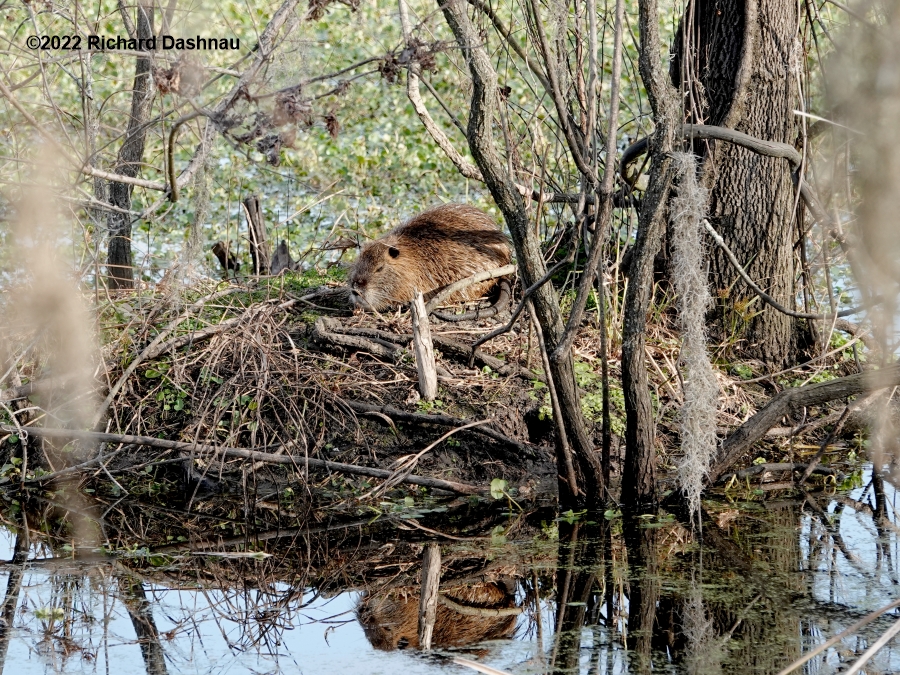
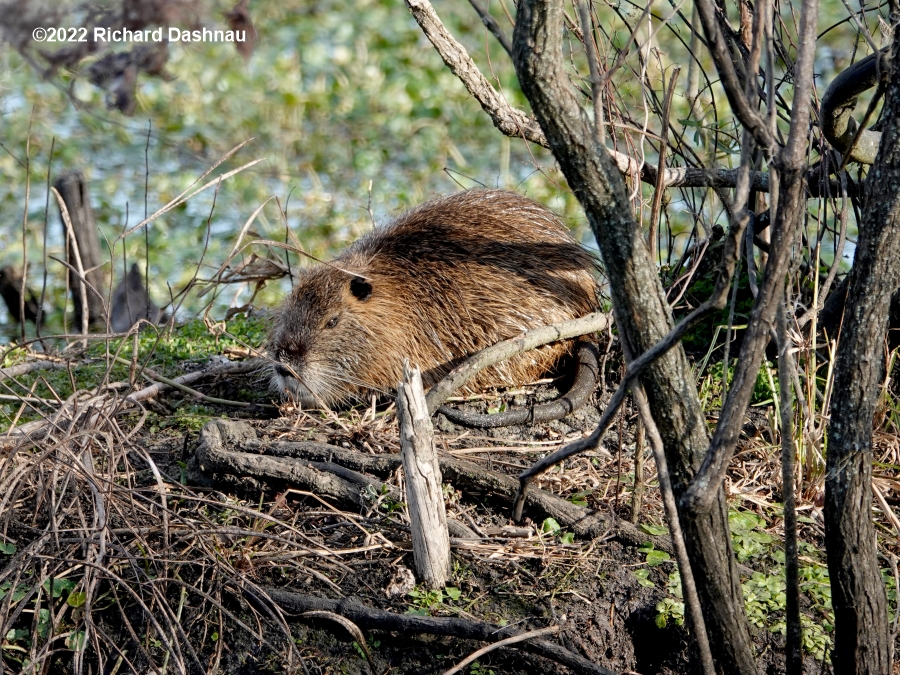
I
got to the dirt mound and waited. While I was there, some friends
of mine (frequent park visitors) came by, and we discussed the Otters.
In 2016 they had seen Otters where the
Spillway Trail ends at the
Elm Lake Trail. We discussed their previous sighting, and of
course we all hoped to see Otters again. They continued towards Elm
Lake. At about 9:45
(about 40 minutes after passing the
Nutria), I considered going back to Pilant Lake, since I thought the
Otters might have already done their morning journey. One of the
friends that
had passed by began calling out to me from the
end of the trail. She pointed into the water. I walked that
way, and she said "Otters!" They had seen Otters in Elm Lake. The
Otters
crossed the Elm Lake Trail and got into Pilant Lake and were swimming West towards Otter Island. Towards me! So I just waited, and watched as they followed the Otters, and
snapped
pictures of them. When they came into view, I tried to get some
images, too. Although they weren't hurrying, they weren't moving
slowly, either--which made them hard to
get focused on. I
filmed what I could, until the Otters moved North, into the tree cover
just before they got to Otter Island. Our visit was about 4 minutes
long. I captured the photos
below, and also this short video clip (mp4).
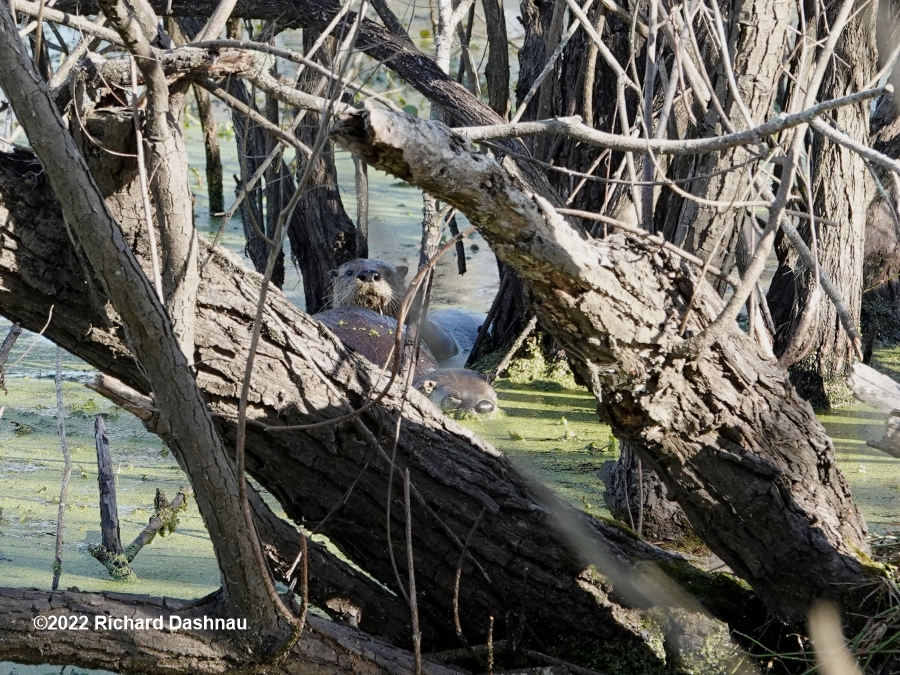
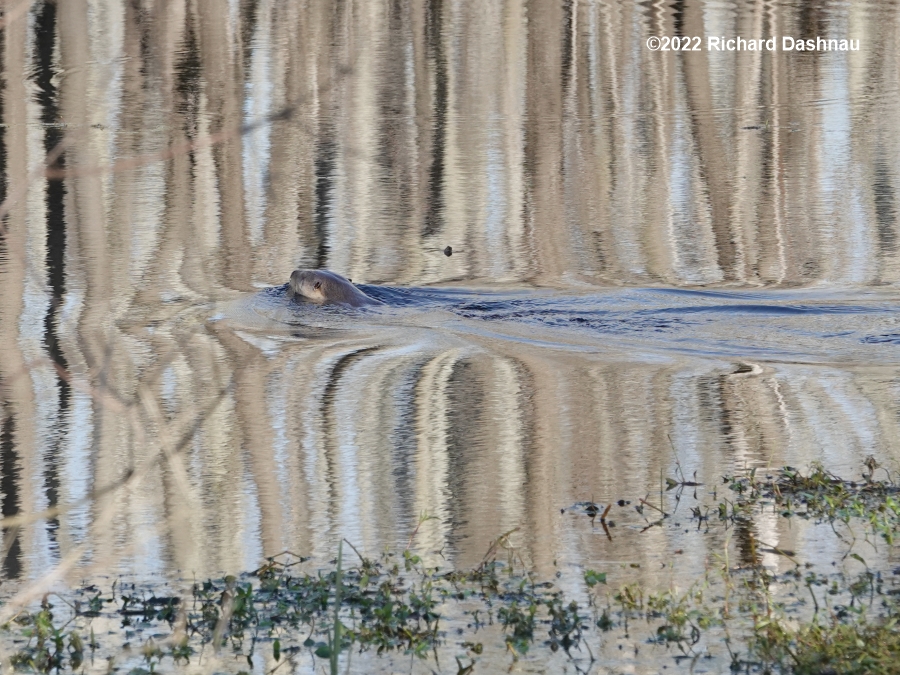
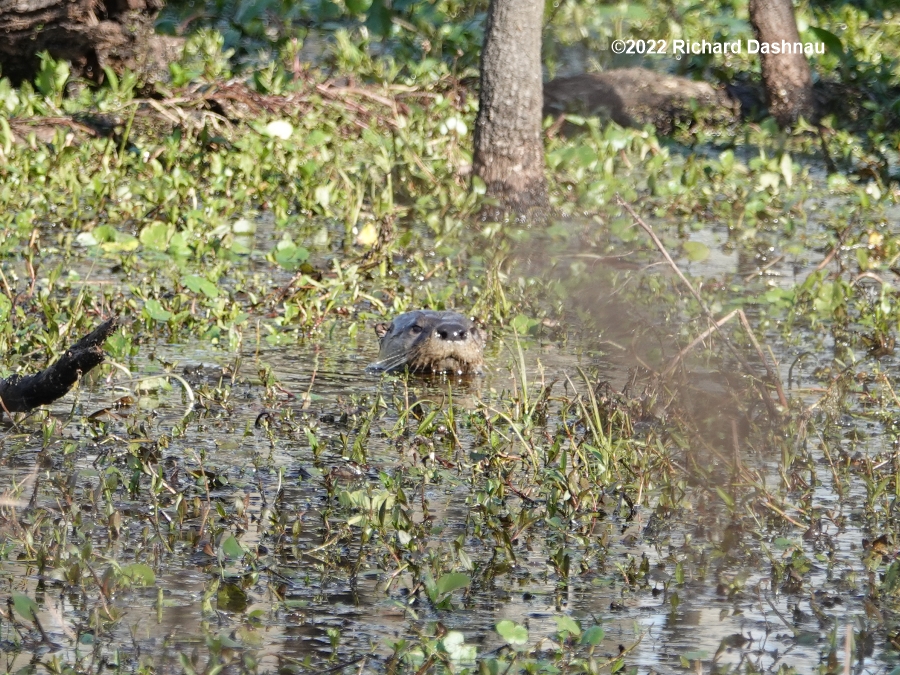
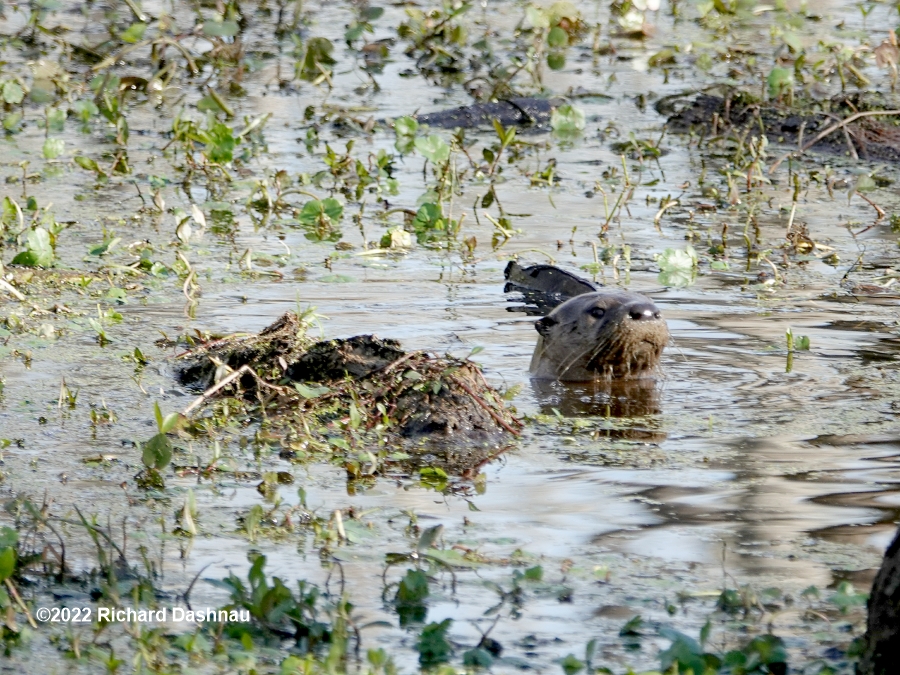
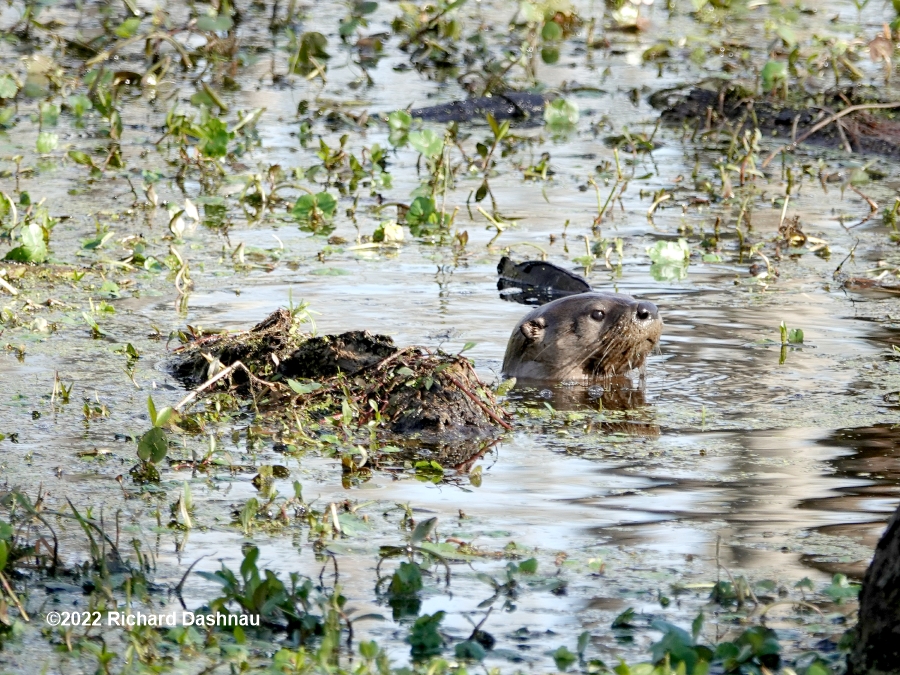
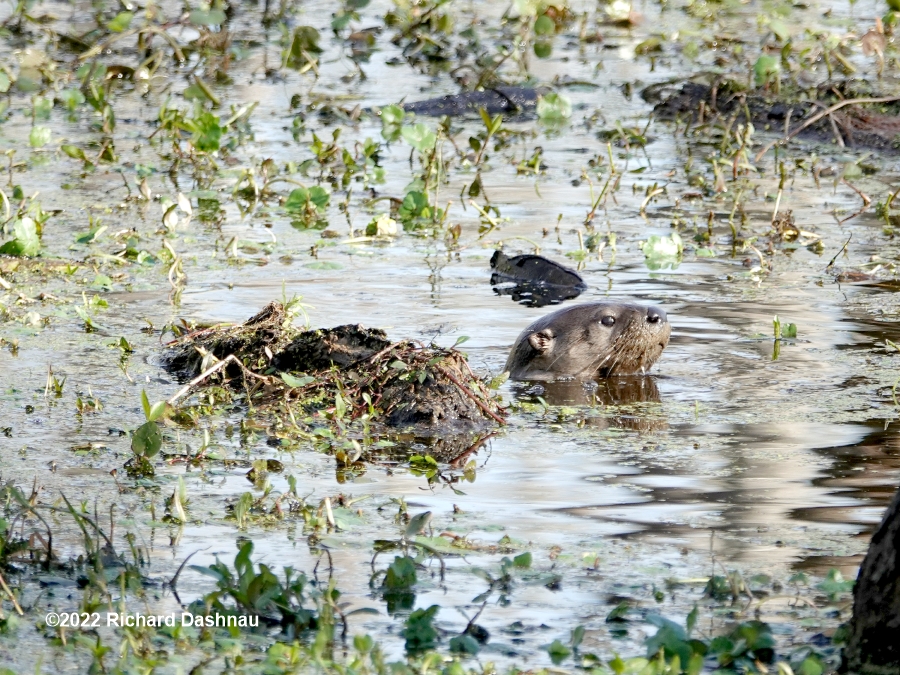
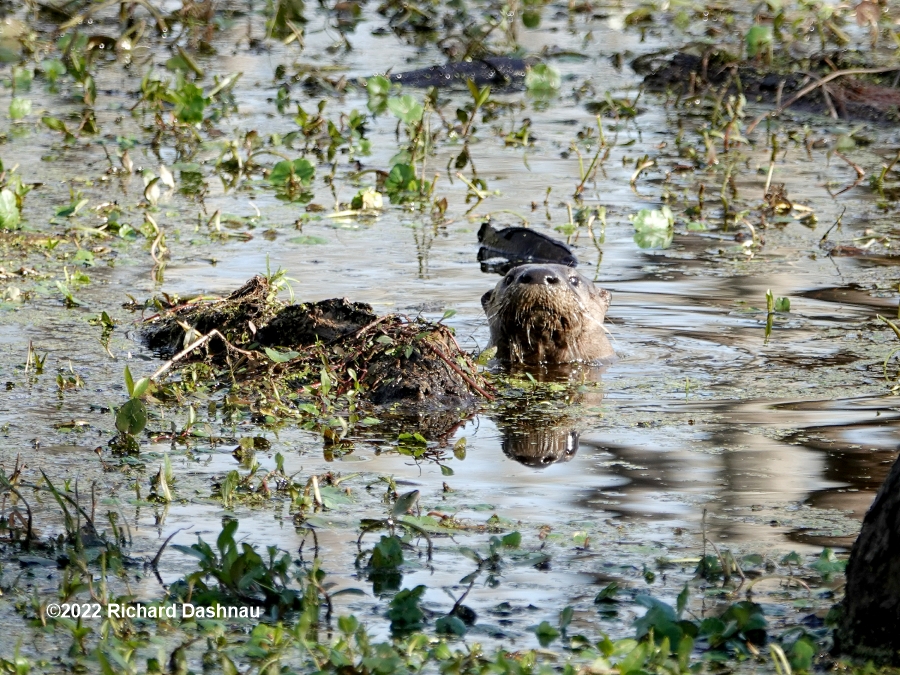
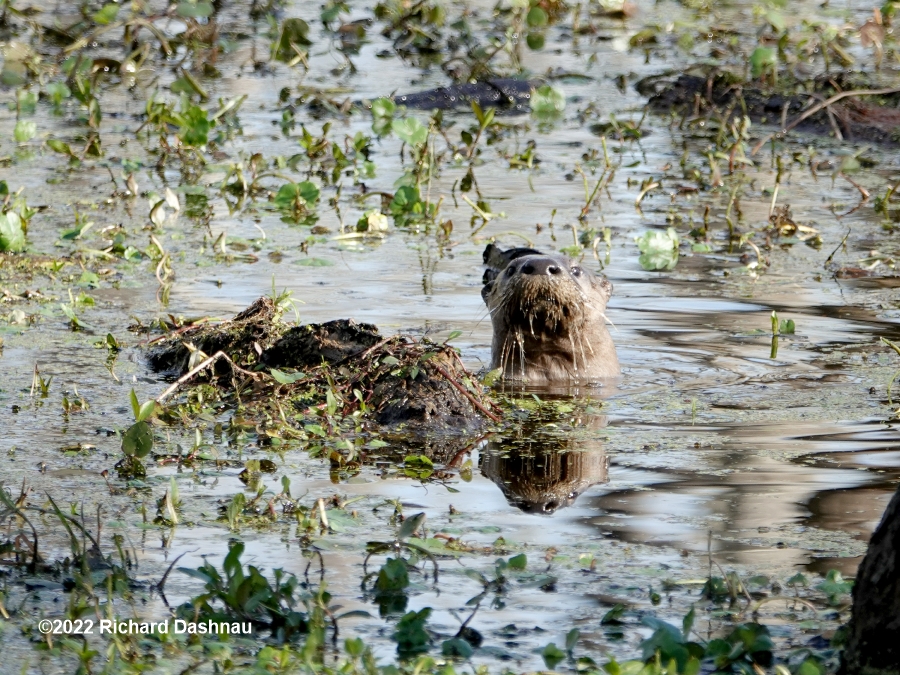
Although
Allligators are one of the most popular animals in BBSP, Otters are a
very special interest for some park visitors. After this last
experience, I looked back over my own sightings of
Otters here. I was surprised to find that, since 2004, this is my eighteenth Otter sighting! At least, according to what I've recorded on my web pages. As time has gone by, I began collecting
the
sightings onto one page. After this last sighting, I decided to
go back and upgrade some of the video clips and images I've uploaded
during the 18 years since my first excited view.
I spent most of
this week finding the old files, reformatting and remastering. I got to
relive the experiences and look at them with better understanding. I
wanted to finish that project before
working
on these recent images. So, here they are, and my Otter Page with
improved video is ready, too. I found a really good description of
Otter Natural History online in 2018:
North
American River Otter Husbandry Notebook, 3rd Edition Edited by
Janice Reed-Smith 2008 I've checked and the pdf is still
available at this link. or copy and paste this:
( http://www.otterspecialistgroup.org/Library/TaskForces/OCT/North_American_River_Otter_Husbandry_Manual_3rd_edition.pdf )
Here
are a few observations from that source--that may clarify some of the
activities witnessed by me and others in the park--and some of my
guesses. Otters behavior is seems to depend on
local
environment (which makes sense), so behaviors witnessed at one
geographic location may not happen at another. So, I picked these, but
"our" Otters may not care, or may have read
different literature.
1)
“Although northern river otters may be active at any time of day, most
activity occurs from dawn to midmorning and during the
evening. The peak of feeding activity apparently occurs from
dawn to midmorning.” I've never been able to see Otters eating at BBSP, though other visitors have. Maybe I need to get there earlier.
2)
"Food passes through their digestive tract quickly, within one to three
hours. Gastrointestinal transit time for a fish meal took
anywhere from 2 to 4 hours with a mean of 202 minutes.
Most
feeding activity seems to occur between dawn and midmorning. The N. A.
river otter spends 41 – 62% of their time engaged in foraging and
feeding activities." This is very different from
the
food requirements for Alligators. Alligators eat a lot less often than
Otters do. Just imagine if we had as many Otters in the park as
Alligators.
3)
“River otters appear to undergo bradycardia while submerged. Despite
this ability to conserve oxygen, the maximum time an otter can remain
submerged is approximately 4 minutes.” Something
to keep in mind while tracking an Otter on the move. Bradycardia=slowed heart rate.
4)
"Daily moves for individual otters ranging from 2.4 km (1.49 miles)
(average for family groups in winter) to 42 km ( 26.1 miles). A 2 mile diameter circle, centered over the Spillway Trail at Elm Lake,
covers
most of BBSP--well within a 2-mile traveling range. Otters have been
seen in Creekfield Lake, New Horseshoe Lake, along Live Oak Trail, and
from Elm to 40-Acre Lake-to name a few spots.
5)
"'Otter Activity Centers' include: pulling out places/landings,
'Holts"=Denning locations, Scent Posts/Latrines= Sprainting sites where
waste matter is deposited by more than one otter.
"Latrine dance" is the treading of the back feet (usually six to eight times) with the tail arched while defecating or urinating. I haven't seen Otters eating, but I have seen them doing "poop dances", and
marking
and using various islands and mounds in the park. From my limited
knowledge, it seems we have one family group of Otters in the park
(maybe 2 ?). Hey, I'm just guessing here.
I've also added a few more pictures showing another large aquatic rodent that visitors sometimes
ask about--usually when they see a Nutria. On 2/18/2007, I was able to
watch an Otter on the Spillway
Trail for about 30 minutes. It had been
there all day, but before I got to see it, I was spending a few
hours watching an Alligator on the bank at New Horeshoe Lake that had a furry carcass in its jaws.
After some hours, the Alligator finally moved enough for me to
see the carcass. I couldn't see its head, but I saw enough to know
it wasn't an Otter. Or a Nutria. Or a Muskrat. Then,
I hurried over
to see the Otter by the Spillway Trail that I'd been
hearing about all day. Here are the pictures--remember, from 2/18/2007. That broad, flat tail belonged to a Beaver (Castor canadensis).
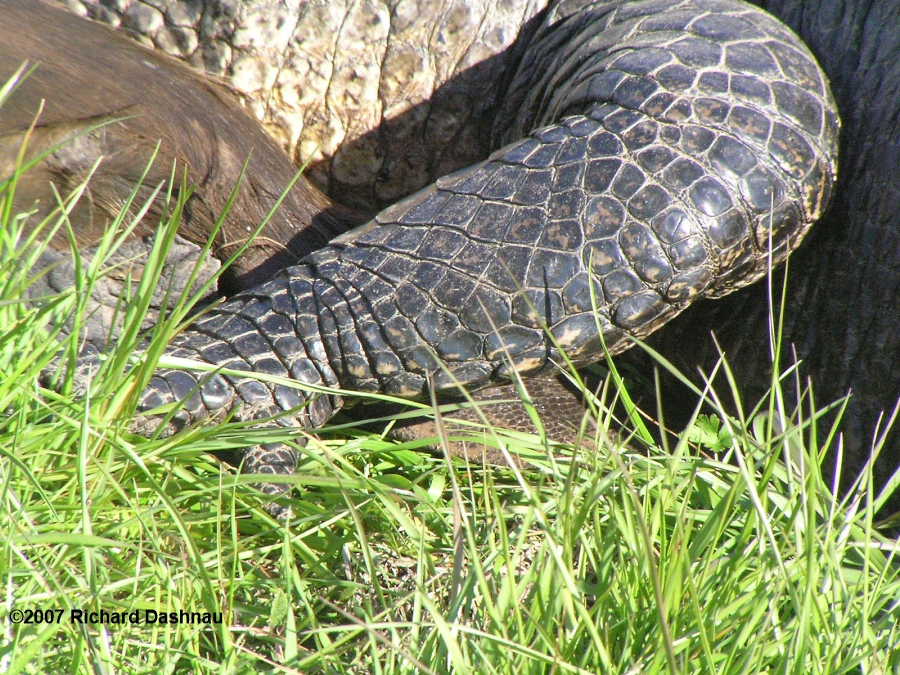
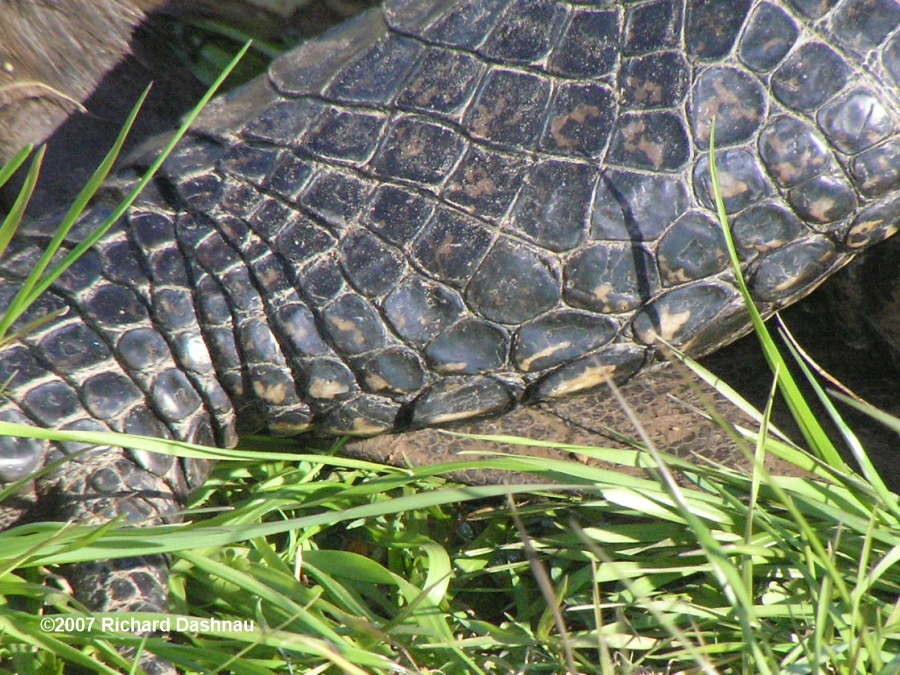
01/16/2022.
Another cold day at Brazos Bend State Park. Please note that there was
movement around me most of the time, so the animals that I mention were
not the only
ones about. I walked to the observation
tower and the open waters there, hoping to encounter otters and/or
eagles. It was about 39�F on the trail. It was an interesting
morning (other events that day are described on other pages). While a group of us were standing near the tower, a park
visitor came back from the spillway trail (she had passed
earlier to go
west.) She said that she'd just been watching 3 otters
playing and eating (from her description, I think the prey was a
siren). It sounded like they were at...Otter Island.
Well, of course we
went to look for them. Otter Island is about 500 yards East
of the Observation Tower. While walking that way, I could see 3
people up ahead on the trail. They
had stopped, and were watching
something to the left (North). They had passed by me earlier, where
I had shown them where the mother gator was. We had also discussed the
possiblity of seeing Nutria or Otters. They told us that they'd
just been watching Otters! Of course, the Otters were gone. But at
9:30 they surfaced again, and began leisurely
moving West. We
followed at some distance, hoping not to spook them, and shooting
pictures with video. This lasted for about 5 minutes, until the Otters turned and went
North-away from us. We walked back to the
Observation Tower. I've put photos (like those below) and the short video clips I captured into this edited video(mp4).
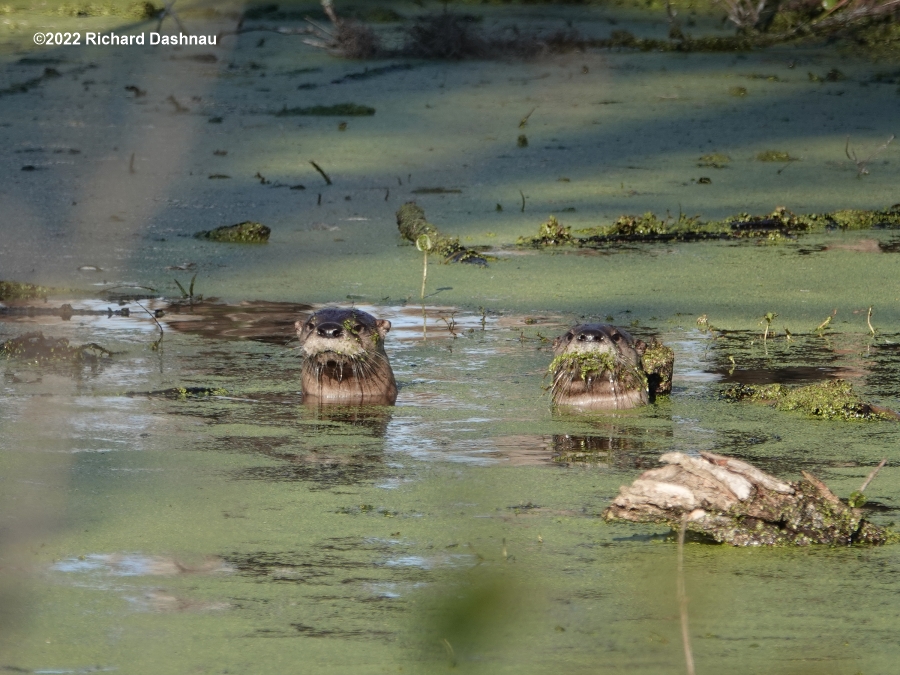
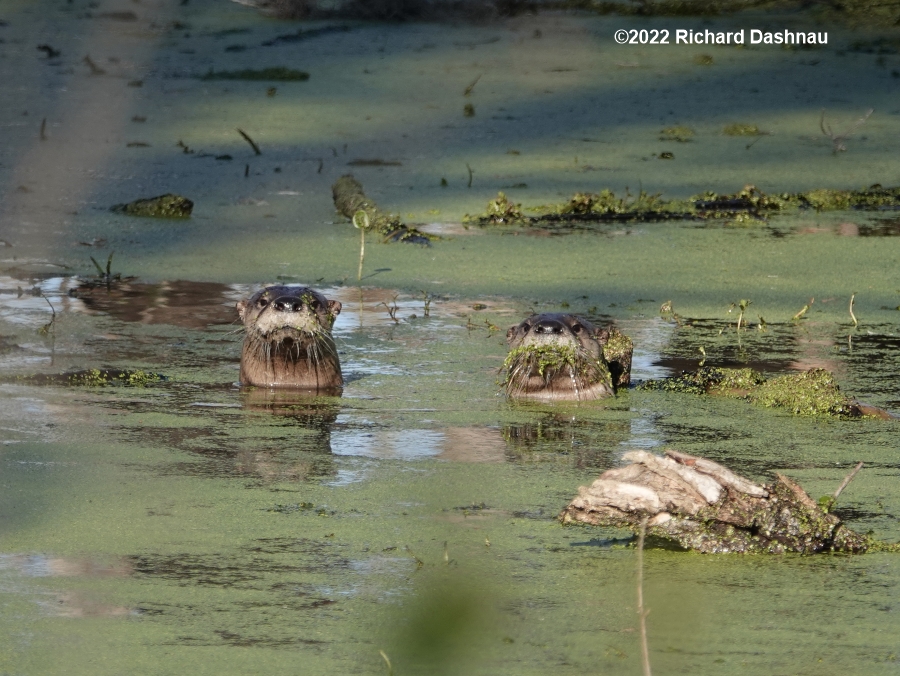
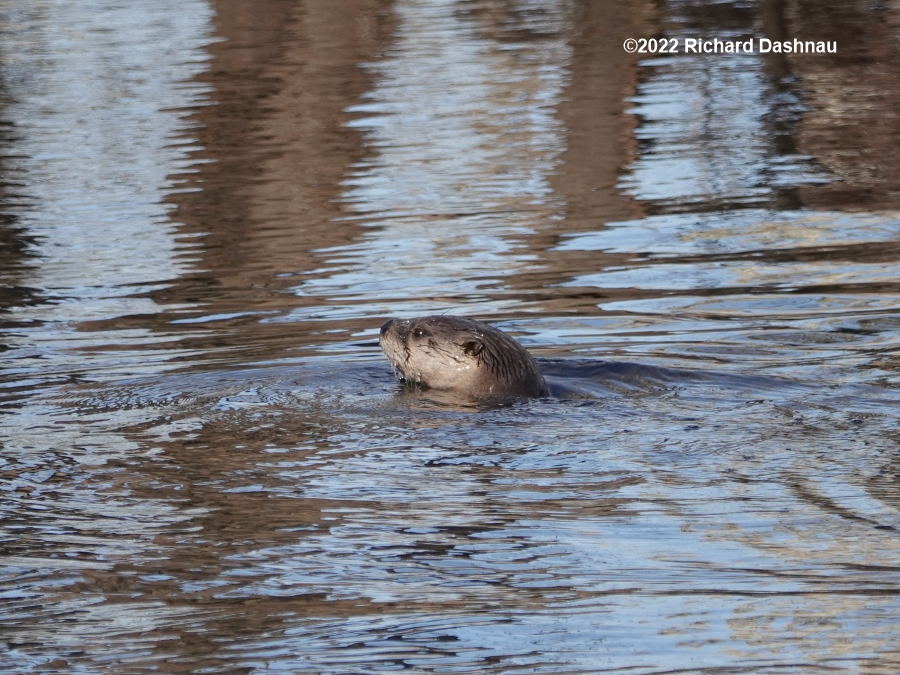
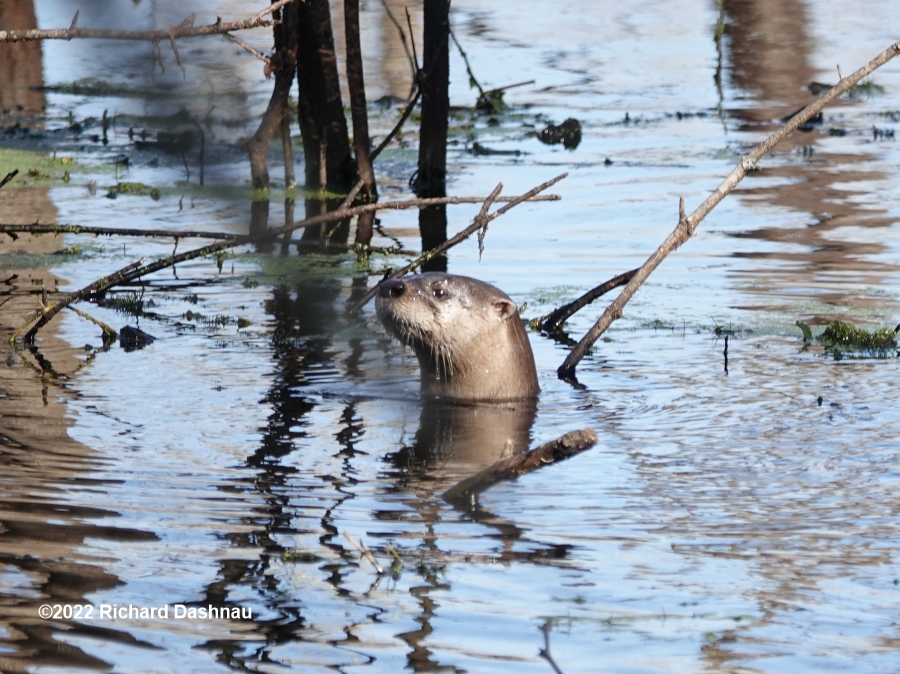
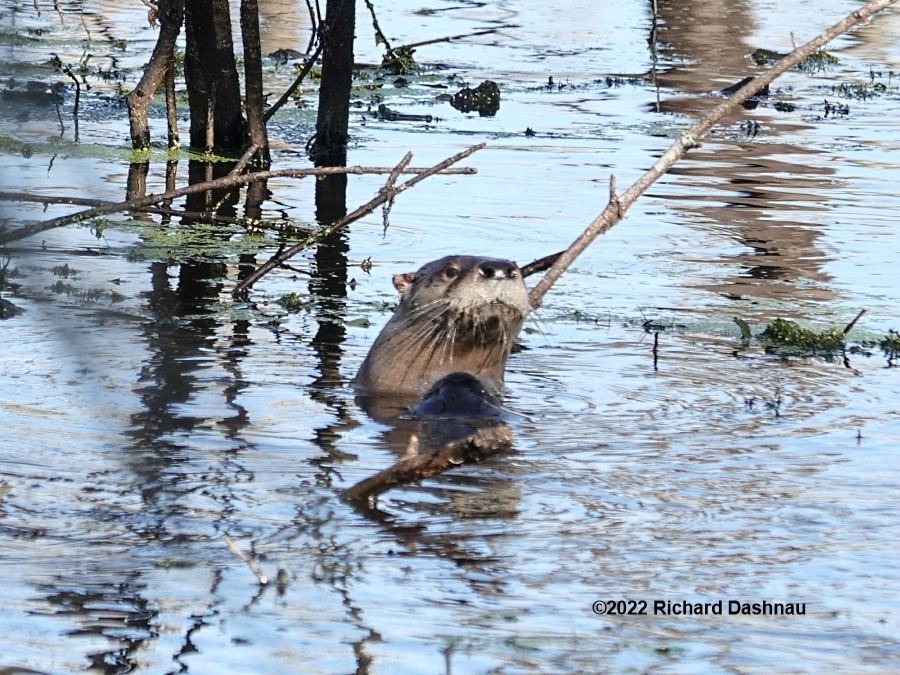
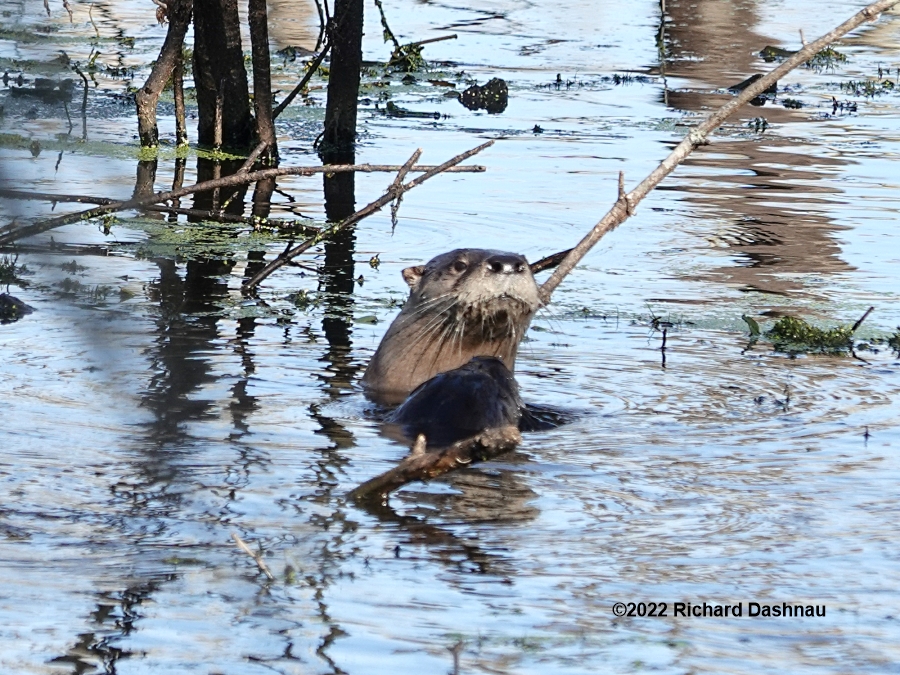
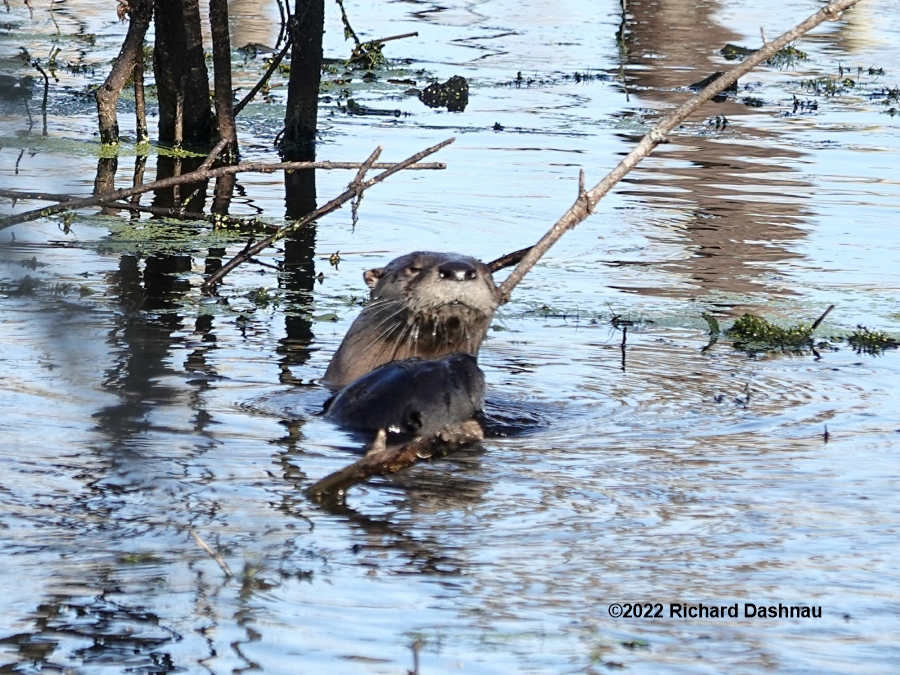
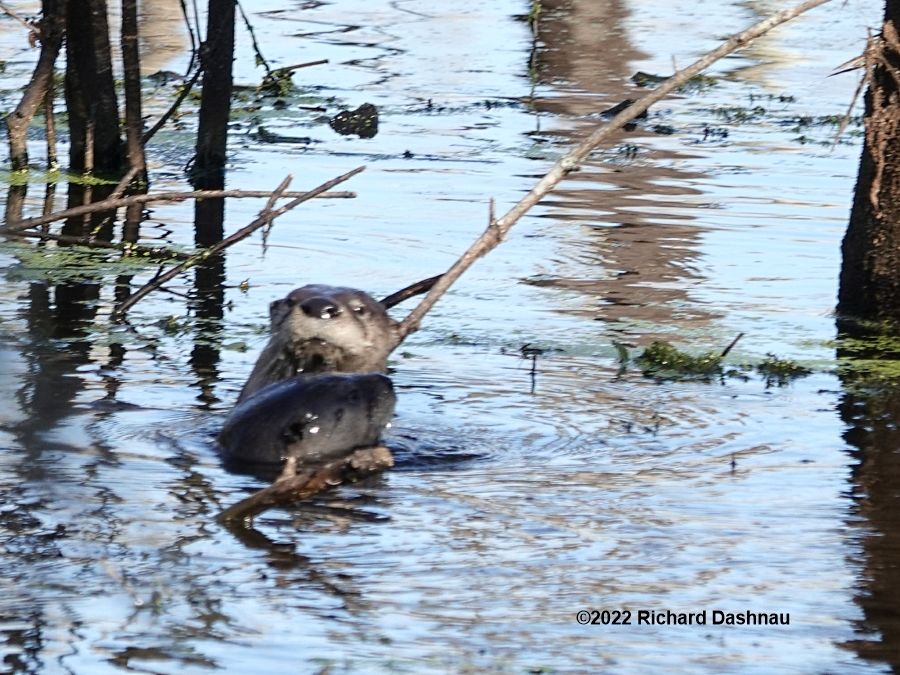
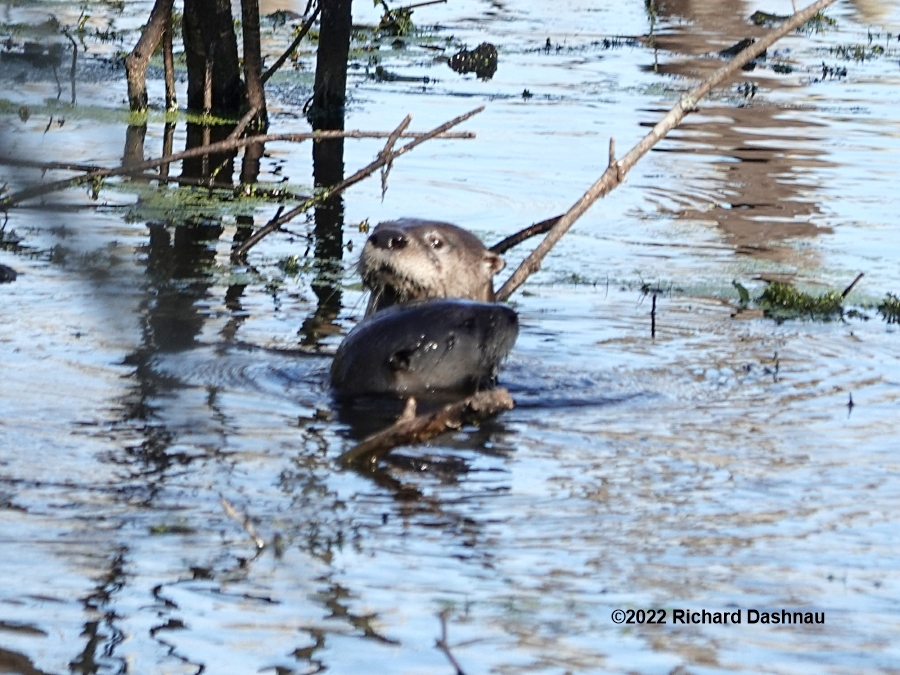
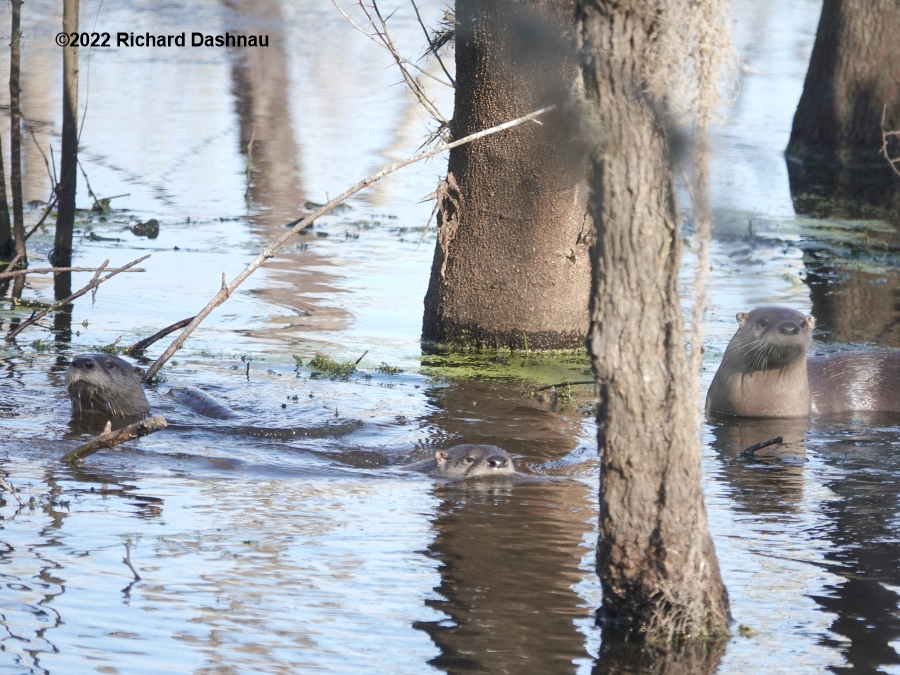
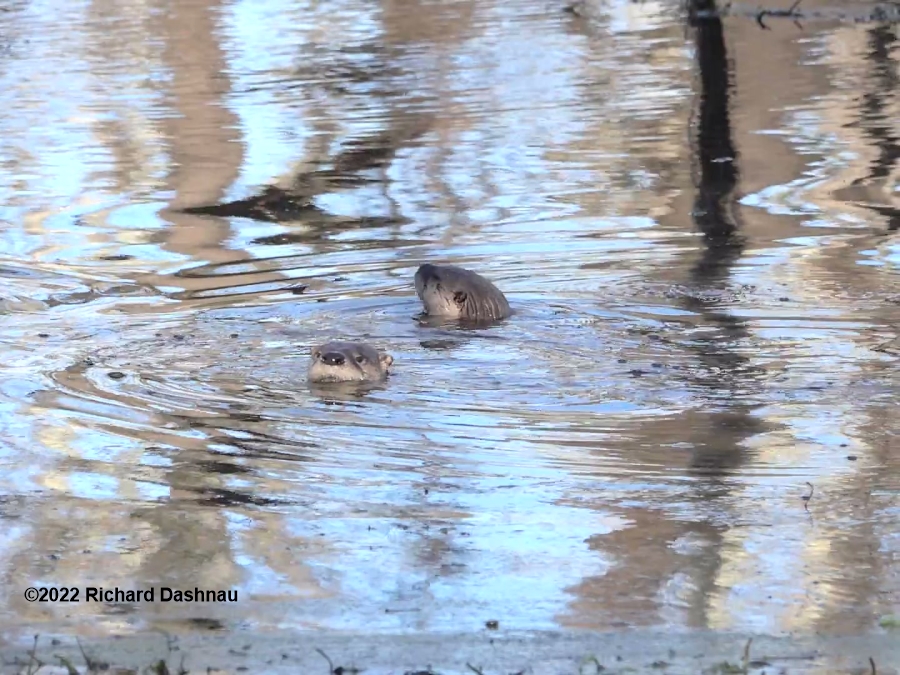
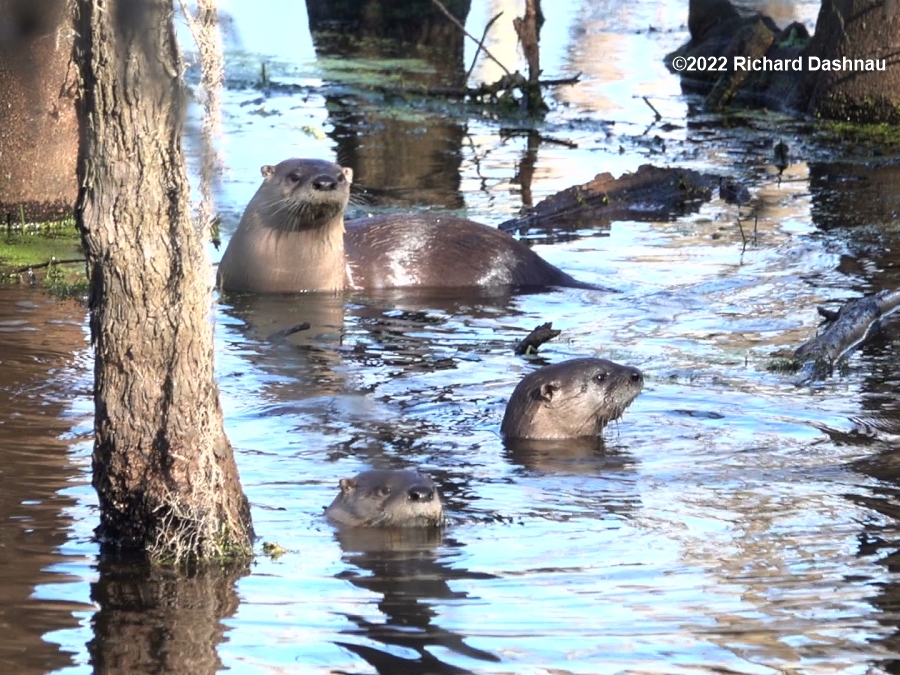
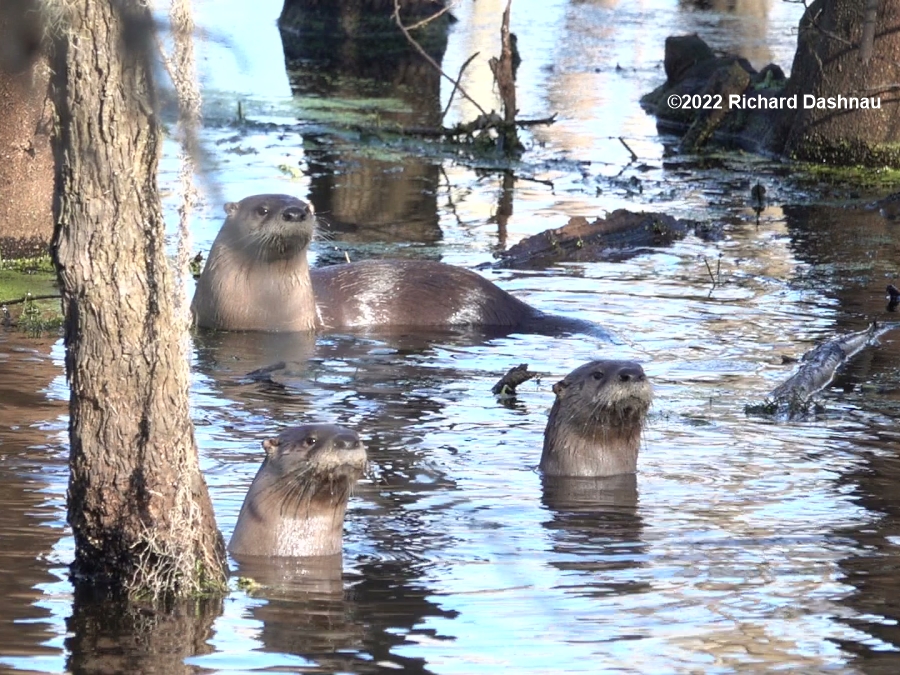
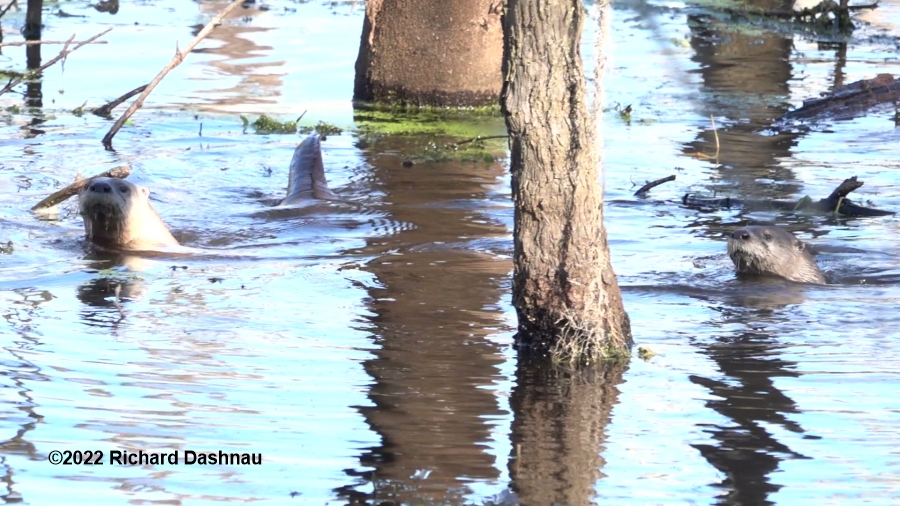
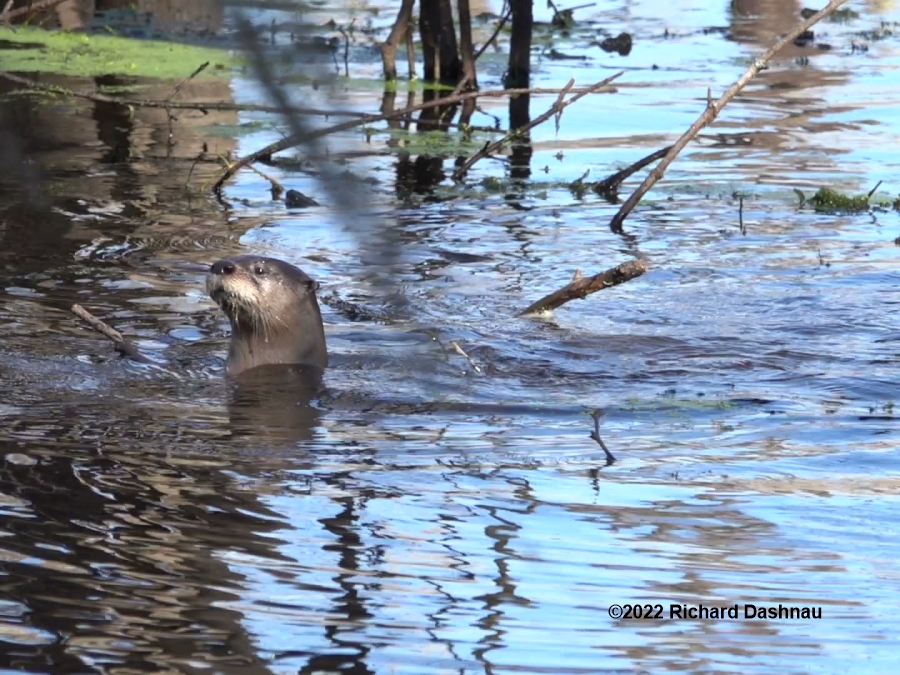
05/06/2018 I
was walking West along the Spillway Trail. I was about halfway between
the Elm Lake gazebo, and the Spillway Bridge--just a little West of
Otter Island (near the alligator
nesting plaque). I was watching the
people on the trail, looking around, and enjoying the day. Then,
I noticed an odd sound amidst the cheeps, croaks, tweets, and grunts
around me.
At first I thought it might be some American Coots but
I turned around and looked anyway. And, at first, I thought it was a
small group of Coots diving and feeding. But it didn't seem right,
and
suddenly I realized I was looking at an Otter! I snatched up my
camera and focused and hit the video button...and then I saw it
was four
otters. There was one that seemed a bit
larger than the other three.
They had left the "island", and were about 20 yards East from me. They
were all looking further down the trail (to the East). I didn't take my
eyes off of the
otters, but I heard a family group coming towards me
from that direction, and they had a dog. I assume the otters were
watching them. While I watched the otters, I heard a
low...grunting
sound, which I thought was coming from the otters. The
family with dog approached me, and I hoped that they'd continue past,
but they stopped, and then saw the otters. The otters moved
off.
All of this happened in about 30 seconds.
So, I did get some
video, and the otter sounds are audible in it. It appears that at least
one is larger than the others, but it's possible that there are two
adults. I've edited this into a longer
video. The first part is the
original clip, and the second part is a replay of the clip, but slowed
to 1/3 normal speed, so we can all spend more time watching them. At
the slower rate, it's
possible to see how one otter seems to be
leading. Here are 3 framegrabs from the video, which is at this link(mp4).



01/07/2018. One of those
days, at Brazos Bend State Park. On Saturday, January 6, volunteer
Chuck D. showed me that he'd gotten some great pictures of a juvenile
Bald Eagle at 40 Acre Lake.
On Sunday morning the next day
(01\07) , I was out at 40 Acre Lake (where I usually start
anyway). I was near the Observation Tower, and watching the sky,
and also looking and listening for
signs of disturbance from the
many wading birds and waterfowl in the area. American Coots
occasionally bickered out in the water and chased each other. Once, the
coots sounded a bit different,
so I looked to my left (North)
until I saw movement in the water near the coots. I wasted a second or
two as I went through what normally moves out there. Anhinga? No. Cormorant? No. Diving
Coot?
No. Grebe? No. Otter!? YES!! It was an OTTER!! I quickly
brought the camera up and started shooting video. I tried not to move
as the otter came closer. It swam to the edge of the floating
hyacinth,
then it dove. It was about 10 yards from me when it went under. The pictures below are frame grabs from the video. And the video is here.
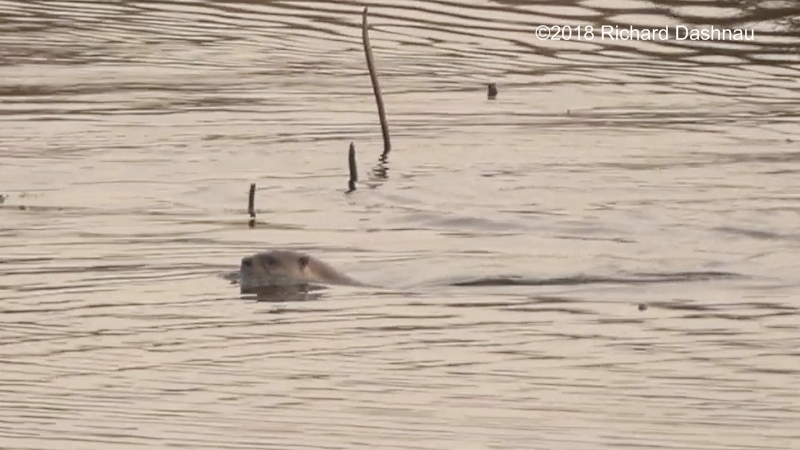
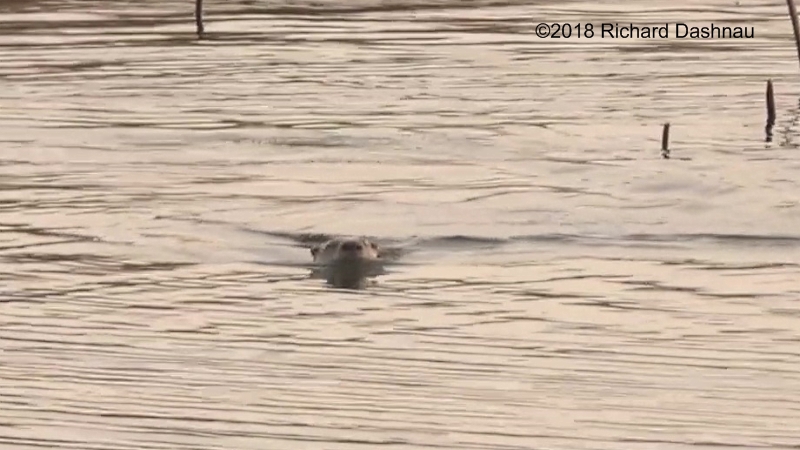
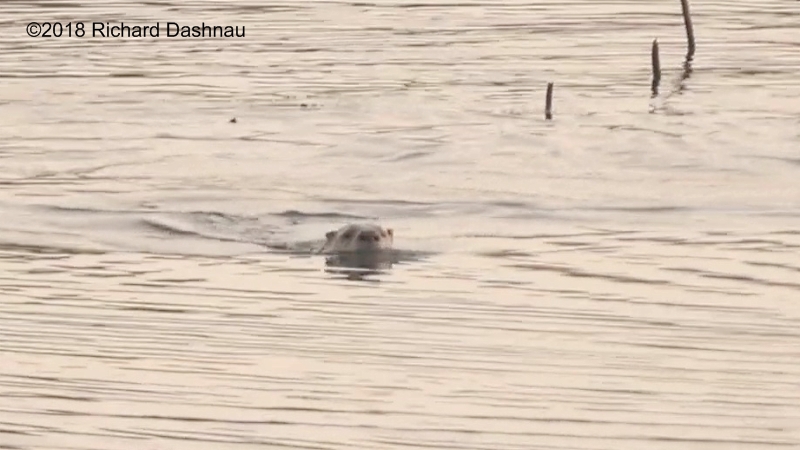
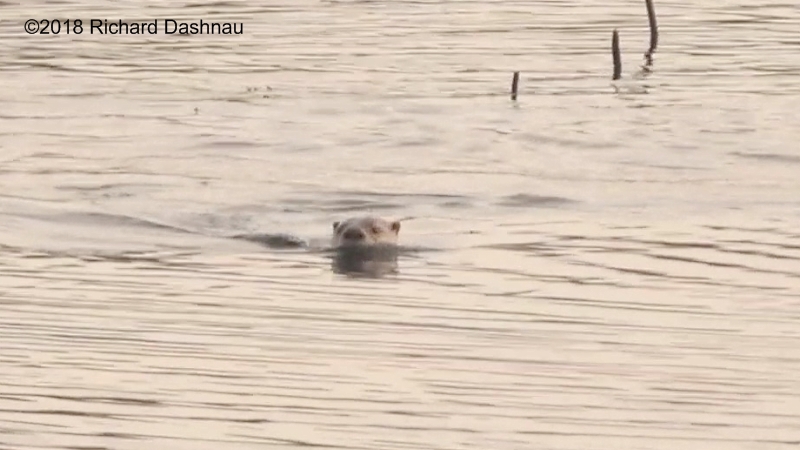
It
seemed to me that it might want to cross the trail (probably close to
the concrete around the culverts). So, following my own advice, I
backed away from the tower about ten steps. This was to allow
room
for the otter to cross. And...nothing else happened. I looked all
around for a sign that the otter was moving. I looked behind me in case
the otter passed me. I looked down and to the right (South)
in
case the otter crossed and went into the lake leaving a wake. I spent a
few more minutes looking back and forth. I didn't see the otter again.
It might have crossed in front of me after that. But I could
have missed it; because I was distracted.
Because...when I was waiting for a sign of the otter I happened to look right again (South), but this time I looked *up*.
And
the juvenile Bald Eagle was circling in the air above the lake. I
caught some video of the eagle as it circled around (it was near the
Southeast corner of the lake) and it made an aborted talon-strike at
the
surface of the water, then landed in a tree. So, while I was watching
that, the otter could have crossed to the East. What a choice!
Should I watch for the otter to reappear...or for the eagle to
move?
I watched the eagle, and it took off again, but moved away from me, then looped around and went West. The images below are frame grabs from the video. The video does look a bit better.
And that video is here. As
for the young eagle. Sources on the TPWD website say that Bald Eagles
lay eggs in December, and eggs incubate about 35 days, to hatch
sometime in January. The chicks
leave the nest in about 12 weeks, but
the parents still feed the young for another 4 to 6 weeks while they
learn to hunt. So eagles hatched this season should still be in the
nest (not flying around). The feather
markings change as the young eagle
ages, with the prominent white head and tail and dark body appearing
only in mature adults (about 5 years old). This one might be close to 2
years old. I'm guessing
by comparing with my Sibley's field guide
and my National Geographic field guide--which show more white patches
on the wings during 2nd year. I'm sure the birders out there can
correct me.
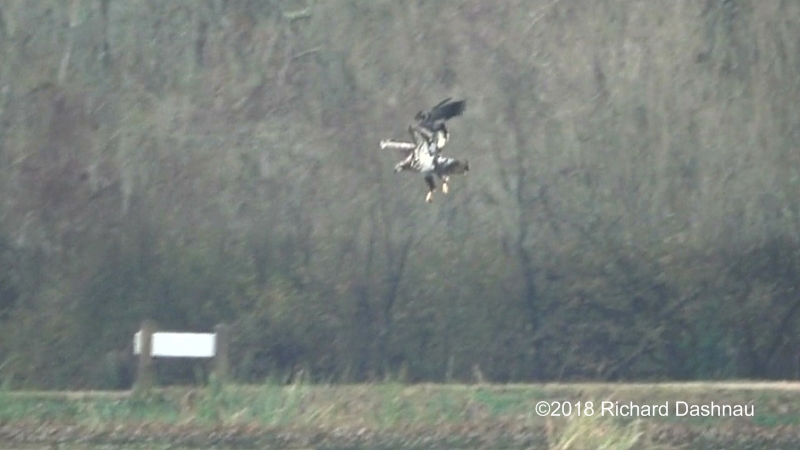
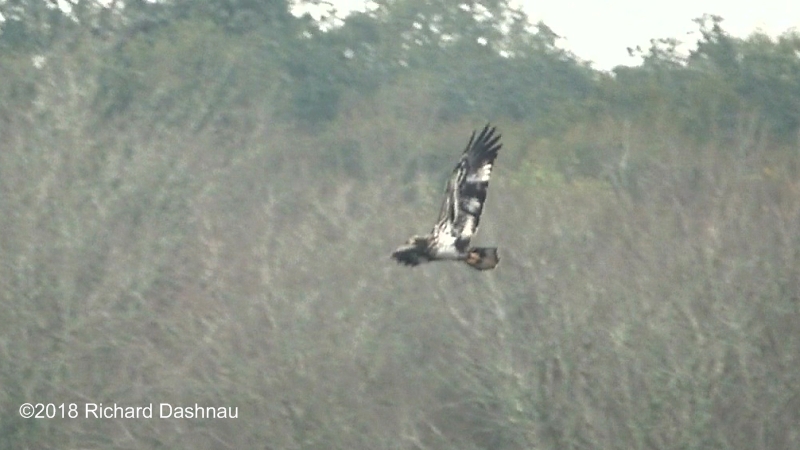
Those
of us who have been able to see otters are often confounded by their
ability to move quickly and with stealth. I found some
information in this document:
North American River Otter Husbandry Notebook, 3rd Edition
Edited by Janice Reed-Smith 2008
Link to the pdf is here.
(
http://www.otterspecialistgroup.org/Library/TaskForces/OCT/North_American_River_Otter_Husbandry_Manual_3rd_edition.pdf
)
The
aerobic dive limit for an otter (how long it can stay under holding its
breath) is 50 seconds. (Page 27) But average dive time is
21 seconds ( page 28). Top speed of an
otter in water is 7 miles
per hour. (That's about 10 feet per second) (page 28) If we
cut that in half (considering we usually see otters relatively at ease)
that's 5 feet per second.
In a 21 second dive, at 5 feet per second,
an otter could move 105 feet (35 yards) or maybe as far as 210 feet (70
yards) if it's in a hurry. There are some good online
sources for
collected information about otters. Some day I'll be able
to examine all that's there. Here are two:
river otter alliance
otter specialist group
12/10/2017. This
winter has been a good one for otter sightings. Most of them seemed to
be along the Spillway Trail. On December 10, I went out to the Spillway
Trail
with the goal of seeing an otter. While I was there,
Volunteer C. also showed up--with the same goal in mind.
I moved towards the East end of the trail, near
a raised section we call "Otter Island", this is near the alligator nesting display.
C.
stayed near the Spillway Bridge-since an otter had run under it a week
or so before. He was about 300 yards from me (according to Google maps)
And so we waited for a few hours. (Image below left)


Around
10:00, I saw that C. had gone over the Spillway Bridge and a little
way to the West of the bridge. I was still in my spot. C.
seemed to be watching something,
so I focussed my binoculars on him.
And that's when I saw the otter run RIGHT IN FRONT OF HIM. He got some
good pictures then, but the otter was so close he had
trouble fitting it all in frame. (Image above right.)
After
that, C. seemed to be following something, so I caught up with him.
He had been following the otter, but stopped to take pictures of a
Vermillion Flycatcher. We
continued West to the Observation Tower,
since it seemed likely that the otter would cross into 40 Acre
Lake. We just got to the Observation Tower...and I saw it
again!
This time, it was about 150 yards South when it crossed the trail. We
saw it go into 40 Acre lake and watched it swim West, where we lost it
when it submerged.
(Image below left, below center)



We
continued West along the 40 Acre lake trail, where we stopped to look
for the otter again. No luck. We spoke to a visitor who was
fishing, then continued West, and then I saw the otter again, on
one
of the islands--near the West end. ( Image above right.) We watched and
tried to get more images until it submerged and we lost it again. The
otter stayed was too far away and in too much cover for me
to get a good picture, so I filmed some video. I've edited that into a clip that can be seen be following this link(mp4). The images below are frames from the video.


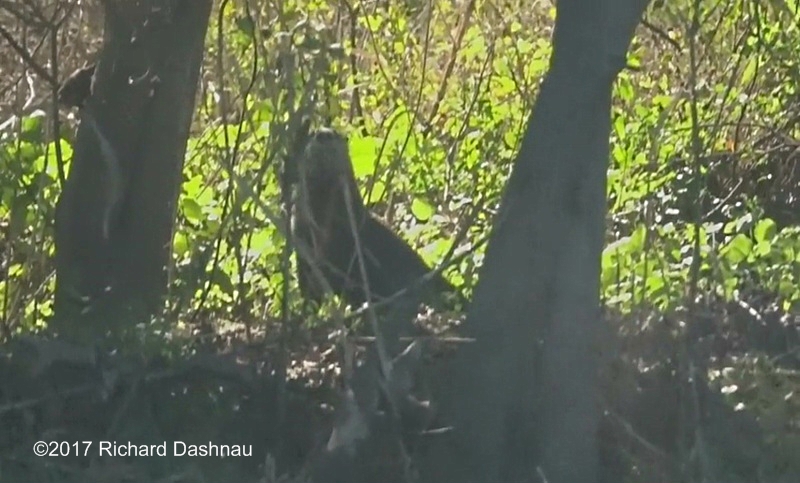


February 09, 2014 When
I got to BBSP at 8 it was foggy, overcast, cold, and damp. Visibility
was limited, and I walked from the 40 Acre-Lake parking lot to the
Observation Tower, moving on the
North side of the lake. I climbed
to the top of the tower, intending to catch the view as the sun burned
through the fog and lit up the park (as was predicted by the
meterologists).
The sun never appeared. At about 8:43, I noticed a
wave moving west in Pilant Slough. It was a "strong" wave, caused by
something large moving quickly under the water.
As I watched, an
otter surfaced, then continued moving West. I watched through my camera
as the otter climbed ashore, then ran under the wooden bridge near the
tower.
Because of my position in the tower, I couldn't see the otter
immediately after it entered 40 Acre lake, but I was able to catch a
glimpse of it as it moved near one of the islands.
I was, of
course, quite excited, and after I lost sight of the otter, I turned
away from the lake, and looked down at my camera. I intended to review
what I'd filmed. I saw movement
in the Slough again.
ANOTHER
otter was swimming West in Pilant Slough! (about 8:46) And, it was
taking almost exactly the same path as the first otter. It also made
landfall and ran under the
wooden bridge. This otter was also visible swimming out towards one of the islands in 40 Acre lake. The two
images below are frame captures from video clips that I shot during
these events.
The edited video is here: mp4 format
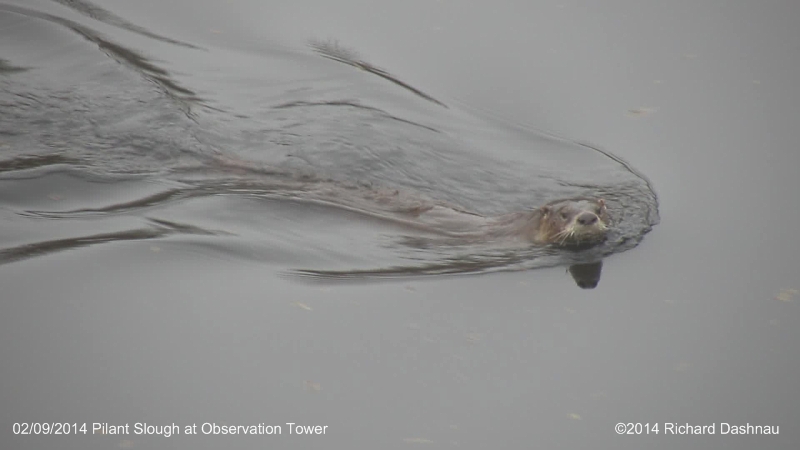
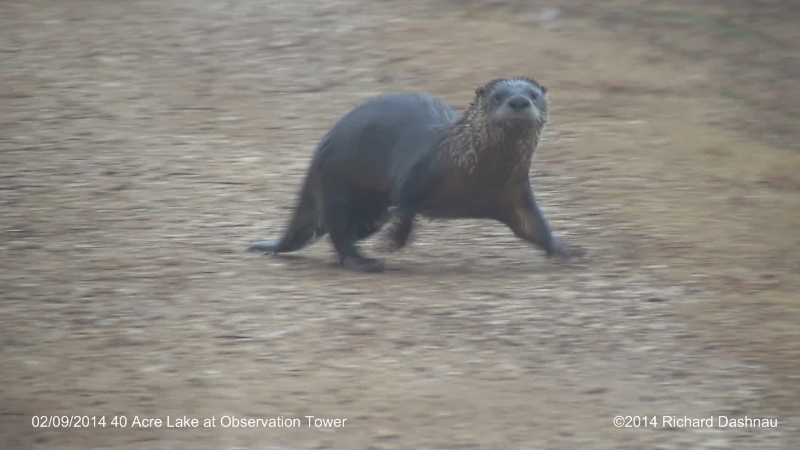
With
the 2 otters out of sight, I stayed atop the tower, and started
reviewing my video clips. Because the fog and the speed of the otters,
I couldn't catch everything I'd seen--but I
did catch quite a bit. As I was looking through the files on the camera, movement below caught my eye again.
One
of the otters had returned, and it ran down the trail towards the tower
(North), and reentered Pilant Slough near the wooden bridge. It briefly
swam East, then stopped and
moved around in the water near the weir. While I was trying to get that in focus, the other Otter ran down the trail (also moving North), and started to enter the slough near the
bridge.
The otter that was already there sped towards the otter on
land-which turned and ran back along the trail, moving South, away from
the bridge. The otter in the water also left
the water, and ran down
the trail; apparently chasing the other one. They both entered 40 Acre
Lake, and once again moved towards the islands. I could see their wakes
moving in
the gap between the islands, so I hurried down to the
trail. I thought that they might chase each other out of the lake, and
maybe cross the North leg of the trail. I got to the trail and
moved
West. I was hoping to see the otters.
I wasn't disappointed.
One of the otters appeared on the island, then entered the water at the
edge of the hyacinth, and it began swimming East-near the island. It
passed me,
then moved towards the corner of the lake, near the
Observation Tower. I could hear the otter making a kind of "chuffing"
noise as it swam. It seemed agitated. It swam to the
bank, then
left the water and ran onto the trail. About halfway across, it turned
and looked at me, then ran towards me a few steps (I was at least 30
yards away); then it turned
and ran back into 40 Acre lake. It
swam past me again (moving West), and moved towards the island. By then
a couple park visitors were also able to see the otter, which was
still "chuffing".
Then
we all discussed what we'd seen. As we were looking for the otter(s) to
reappear, another park visitor walked over. He had come from the
Spillway Trail. This visitor told
me he thought he'd seen some
otters. I assured him he probably had, because two had just come from
that direction. Then this visitor told me that earlier he'd
watched 2 otters
earlier that he'd thought were mating. He said
that one was holding tightly to the other, from above and behind, and
that they also were moving in the water together--sometimes
submerging.
He said the he didn't think they were fighting or playing; and that it
looked like they were mating. He told me he'd moved on so he wouldn't
disturb them.
One of the otters appeared again. It was on one of
the islands, then entered the water, and crossed towards the north side
of the trail. I thought it would cross, but it turned around
and
went South into the deeper water again. It appeared one more time, and
I lost sight of it when I dove under the Water Hyacinth. By the time of
this last sighting, it was about 10
am...so the otters had been visible (on and off) for about an hour and 1 half!
What a great morning!
November 27, 2011 It
was a bit chilly at the park today. When I got there at about 8:30, I
walked down to 40 Acre Lake, where I saw Chuck on the trail. He told me
he'd seen 2 Bald
Eagles a little while before. So, I continued to
the Observation Tower. I stayed at the corner of the trails for a
while, watching for whatever would come along. Later, I walked to
the Elm
Lake water station, watched for a while, and decided there were
more birds active back at the Observation Tower. So, I went back.
I
went up to the top of the tower, and spent a few hours watching for
Eagles and Otters, and getting cold. I finally had enough of the last
part, and decided to make my way back to the Nature
Center. This was
just before noon. Since the sun was high, and I was walking back to
the parking lot, I decided to turn off my camera. I was pretty cold by
then. I was near the center of the
middle island when I looked to my
right (at the current "ditch" in Pilant Lake)....
...and saw 3 otters swimming towards the Observation Tower (also, towards me).
I
brought up the camera, remembered it was off, turned it on, waited the
few seconds for it to come on...and watched the Otters. They came
closer and were going to pass (I hoped) within
about 15 yards from me!
That's pretty close, and I was out in the open. I decided to shoot
high-speed video to stretch whatever screen time I would get. I filmed
the first clip without changing
anything because I really expected the
Otters to see me and leave, and I wanted to get something. They
didn't leave, though, and when they passed behind some brush, I was
able to turn
and zoom the camera. then, they "broke cover"--sort of.
When they came out from behind the bush, they were underwater!!
I filmed anyway, just in case they'd pop up. I got nice video of 3 wakes. While
they were underwater, I took the opportunity to turn and follow them for
a few steps. I didn't want them to surface
and see me moving though, so
I didn't go far.
The Otters surfaced, and I was able to shoot a
few more clips. But I wasn't fooling the Otters, and before they went
much further, they turned and moved into the rice. Two of them did at
first, and
the third followed a bit afterwards. Altogether the Otters
were near me for about 5 minutes, a couple of which they were behind
cover. So, here is a link to the edited video(mp4). I left the underwater
stuff in, since the wakes
are pretty distinct anyway. The images below are frame grabs from the
video clips.
-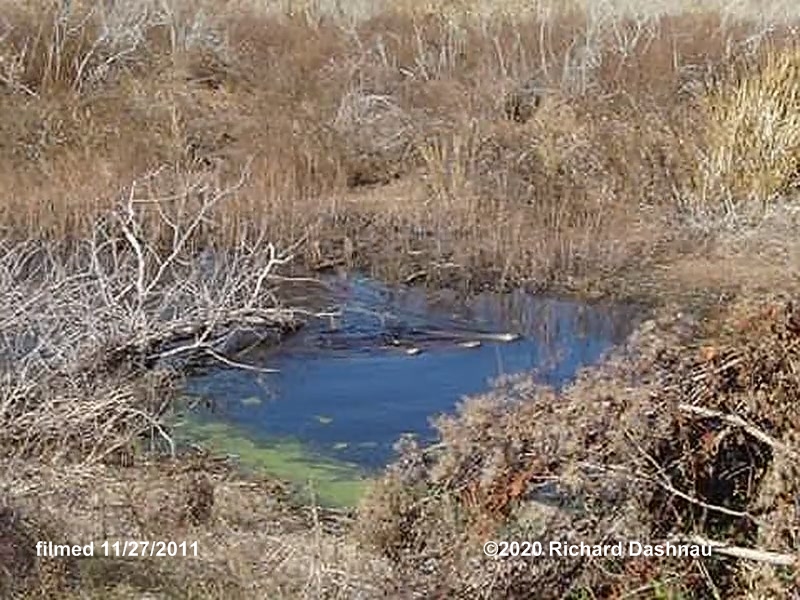 -
-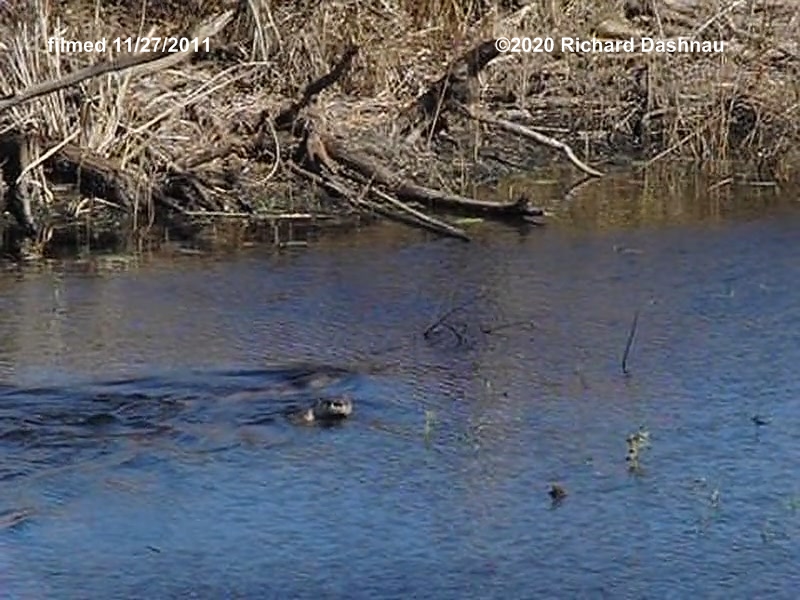 -
-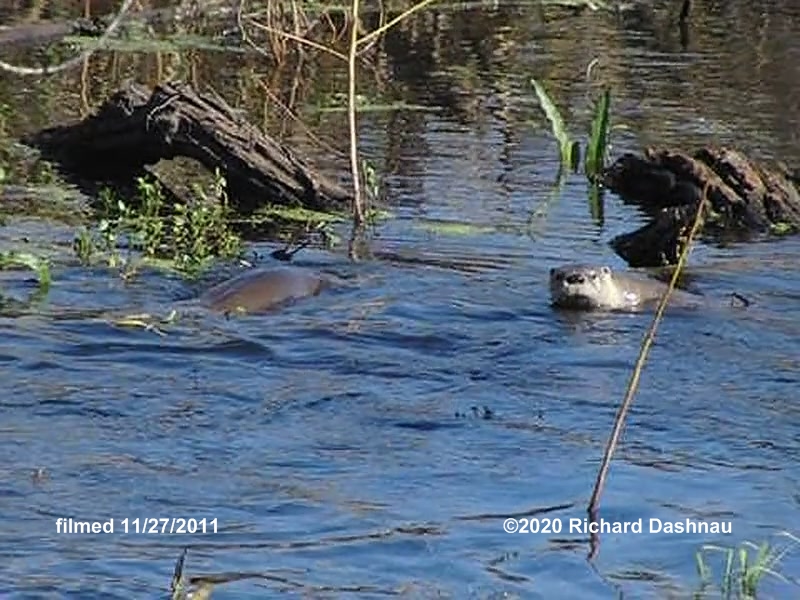 -
-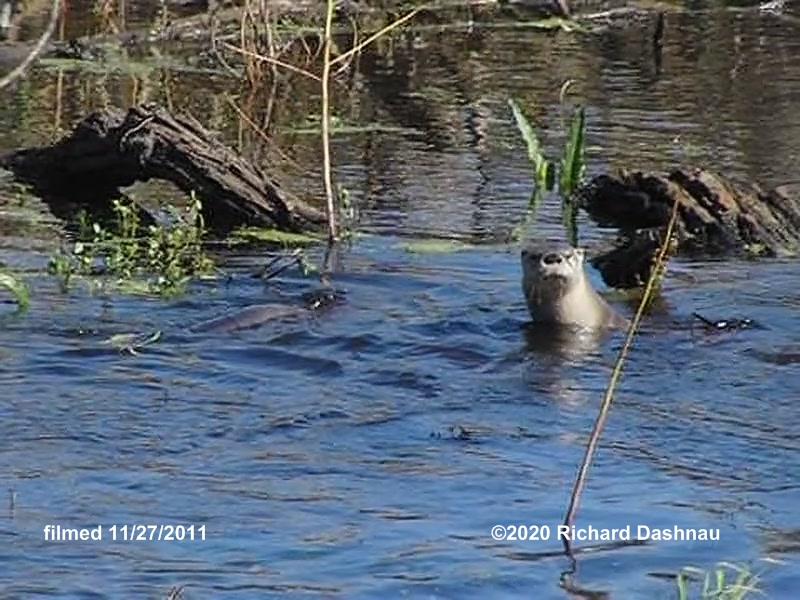
-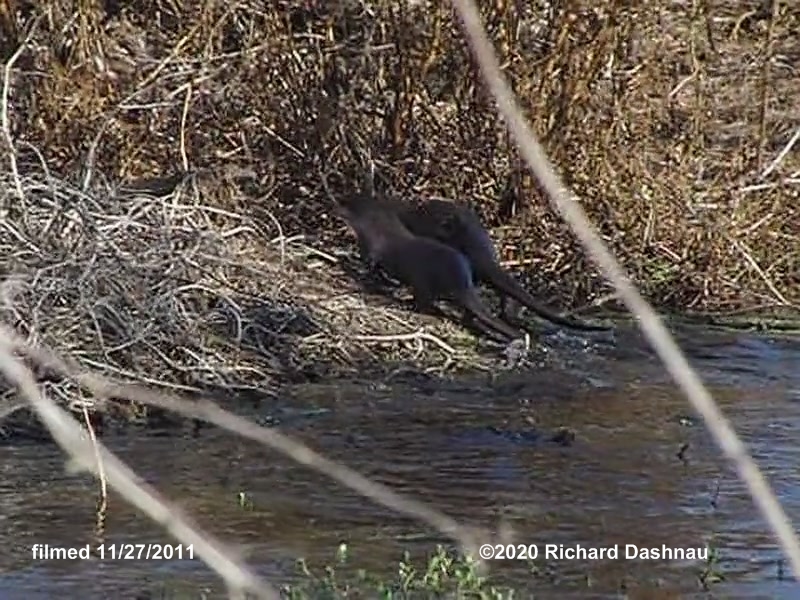
October 23, 2011 It
was about 8:00am Sunday morning, 10/23/11. I had just walked out of
Snowflake donuts on Crabb river road when my phone rang. It was David,
calling from the the park. He was
near the observation tower, and he
told me that he'd just seen an otter cross the trail about 100 yards
east of the tower. It went from 40 Acre Lake into Pilant Lake I should
have been at the park at that
time. But even if I was, I might not have
been where the otter was. Going to the park with the object of seeing
an otter--an animal which is rarely observed there--and actually
*seeing* it requires a large
amount of luck. The park covers about 5000
acres. We have 7 lakes, a slough, and two rivers there. I believe
otters have been observed in all of those bodies of water (except,
perhaps, Hale lake) at
some time. Aside from a few wonderful
exceptions, most of the otter sightings I've heard of have been between
10 and 60 seconds long. So one has to be where the otter is for that
*exact* 10 to 30
seconds. And...one has to be looking in the right
direction. I've been told of an otter crossing the trail behind me
while I was unaware--and I've seen them cross trail behind other people
who were also
unaware of the otter's presence.
But I arrived at the
park with high hopes of seeing an otter on this day, anyway. Otters
sightings at the park had suddenly spiked over the last month or so.
It happened that on this Sunday, the park was
hosting the Brazos
Bend Gator Run, so our trails were host to a number of folks running by
at irregular intervals. I went to 40-Acre lake, and moved to a spot on
the north side of the trail. I was near the
bend in the trail, and
thought--since the sun was coming out and the evening had been
cool--that I could scan the entire trail from the Observation
Tower almost to Hoot's Hollow for any alligators that
might decide to
sun themselves where the runners were. If one appeared, then I intended
to go near it and guide runners past it.
It was about 45 minutes
later, and no had alligators appeared at all. I was facing 40 Acre
Lake, scanning the trails to either side of me, and the islands in
front of me. Of course, I was also checking the
water, looking for an
otter. While looking down the trail, I caught movement out of the
corner of my eye--behind me, in Pilant Lake. I turned, and an Otter was
coming out of the rice right behind me. There
was a little water in
front of the rice at that spot, and the Otter stopped, then slipped
back into the rice when I turn around and raised my camera and shot a
picture. Todays RICKUBISCAM is the picture
I shot. I took the
opportunity, after the Otter left, to turn around. A few seconds
later, the Otter reappeared, about 5 yards further west, near the
deeper water. I was ready, and was focusing the camera
when I heard a
runner approaching. I shot a burst of pictures, and the runner came by,
and the Otter moved back into the rice. This animated gif below is the
burst I shot. And the single larger image is
one from the same burst.
---------------------------------------------------------------------------- -------------------
-------------------
A
seconds later, the Otter came out again, even closer to the water. Once
again I focused, and *another* runner came by. I shot another burst of
photos, hoping for the best; and the Otter moved back into
the rice.
The animated gif below is from the second burst of pictures that I
shot. And the single larger image is one from the same burst.
---------------------------------------------------------------------------- -------------------
-------------------
After
a few more seconds, the Otter came out *again*! This time, it moved to
the water, and was starting to get in. I was sure that it intended to
cross the shallow water, then cross the trail and go into 40 Acre
lake. I had the camera up, and was reaching for the video camera
on the tripod--when a bicycle came from the other direction. This time,
the Otter *ran* back into the rice and I shot some pictures of its
disappearing backside. And this animated gif shows the Otter leaving.
----------------------------------------------------------------------------
The Otter didn't reappear. There usually aren't this many people on the trail at this time on a Sunday morning.
So,
the entire sighting lasted about 2 minutes (first image 9:12 last image
9:14), but the Otter only appeared for 10 seconds at a time.
November 21, 2010 Most
of the images below are frame captures from video clips I shot that morning,
and which I edited into this movie
clip (mp4).
I was
enjoying the quiet Sunday. At about 10:20am I was on the trail on West
side of Elm Lake. I'd just talked to two pairs of park visitors about
Anhingas (one was standing on a submerged log right in front
of me) and
cormorants. Both couples had moved on, and were heading South, towards
the water station.
As I
was looking through my camera at the Anhinga, intending to film it diving,
I heard one of the park visitors say, "Excuse me, but do you have otters
here?"
Most
folks who know me, know the effect the word "otter" can have--especially
on me.
"Yes,"
I answered, "Why...did you see one?"
The
visitor replied, "Yes, I think so. Right over there." And then he pointed.
"WHAT!?"
I said, and walked quickly over to where the people were, standing
about 12 yards from me. "Where is it?", I asked. He pointed again.
"There
are two of them." said the couple.
"Three!
One ran in front of us and went towards them.", said the other couple as
they walked up.
"WHAT!?
THREE!?" I said, probably losing any credibility I'd built as the cool
observer of nature that I'd just built up not 10 minutes hence as I talked
about the Anhingas. If that didn't do it, then when I said, "It
ran right
in *front* of you!? How cool is *that*!", probably did.
I looked
where they were pointing, and sure enough, two Otters surfaced in Elm Lake,
swimming around and making their way South. When otters swim, they sometimes
move through the water with powerful
undulating movements of their bodies;
moving forward while diving and surfacing. I call this "porpoising" since-in
my mind-they are moving like porpoises ("Dolphining" just doesn't sound
right.) They were
swimming pretty quickly, but I didn't want to run after
them and scare them away. It seemed like they were heading towards our
trail, so I hung back a bit to see if they'd cross the trail and go into
Pilant Lake.
They did, but they took advantage of cover around a slight
bend to do it. I just barely got the camera up in time to catch a blurry
view of the last one crossing the trail--just a bit North of the Elm Lake
water station.
Since
they'd already crossed, I quickly walked up and saw them swimming away
from me in Pilant lake, along the Spillway Trail. I followed, walking fast.
The
otters were still porpoising, spending just a second above the surface,
diving, then repeating the cycle. While they were under, I tried to walk
faster to get closer to them, then when they surfaced, I'd slow.
They approached
the floodgate just past the water station gazebo and I could tell by the
water movement that they were right at that opening, but I couldn't sneak
up to get a close look at them. As I slowly walked
forward, two of the
otters swam away from me. The third was ahead of them, and closer to the
rice and the trees.
They
moved close to the rice, and were swimming along the boundary until they
got to one of the low islands. There, they stopped their swimming, and
were craning their necks, raising their heads above the water
and looking
for...something. Meanwhile, I tried to shoot some video, trying to
catch the otters together, or pick one to film.
Suddenly,
there was an explosion of water near them! They'd surprised an alligator--or
the alligator had surprised them--and the three otters retreated a few
yards. Then, they calmly regrouped and moved back
towards the gator; and
then moved into the trees and out past the islands where I lost sight of
them. All of this took about 10 minutes. I had been concentrating on watch
that Anhinga take off, and I would have missed
these Otters that were just
30 yards away in another direction, if not for the park visitors.
What
a morning!! The pictures below (except for the satellite view (from Google
Maps) show the moment the Otters surprised
the alligator (or vice versa).
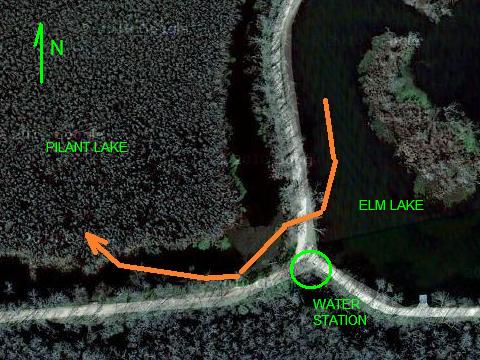 --
--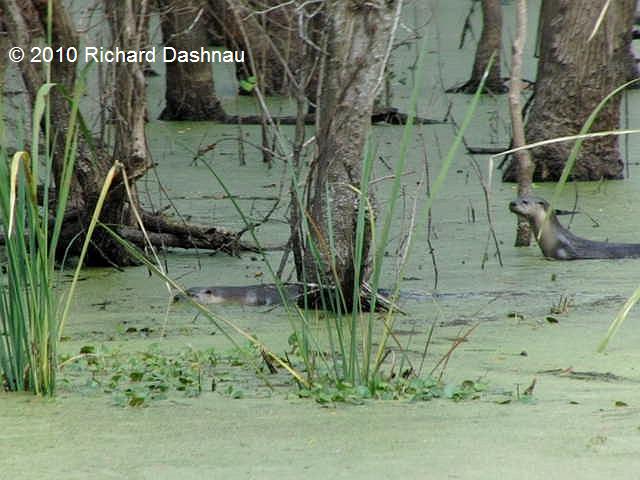 -
-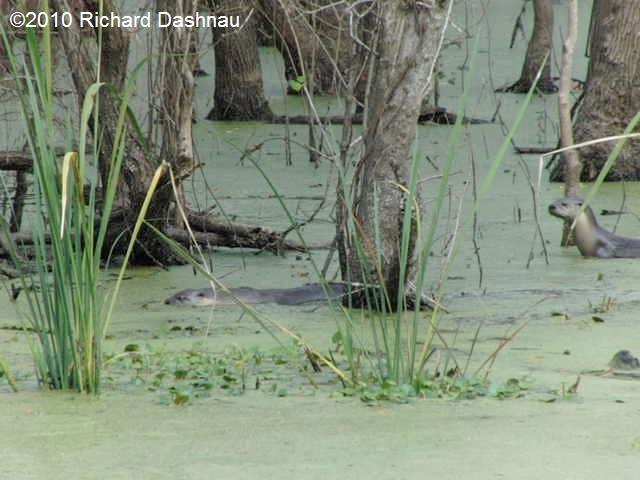 --
--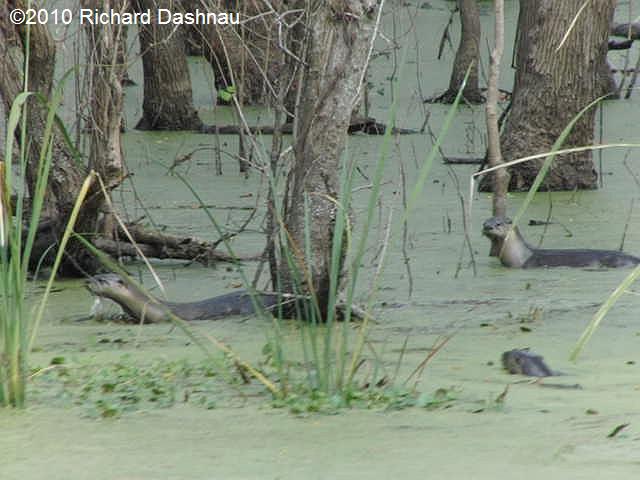 --
--
MAP
OF THE
ENCOUNTER
THEY KNOW SOMETHING'S
THERE
SNEAKING
CLOSER
CAN'T QUITE SEE
IT

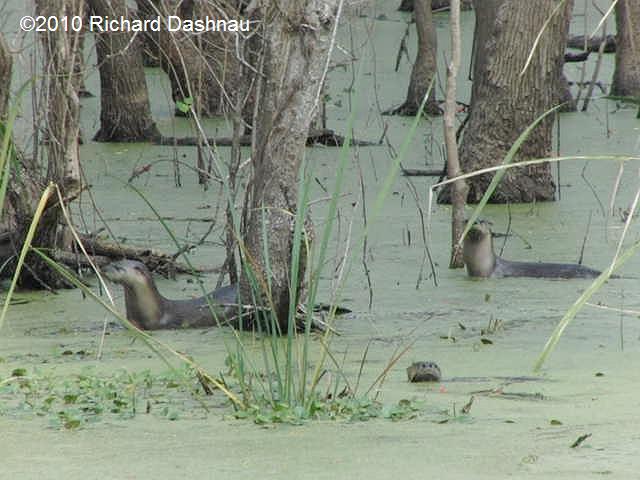 --
--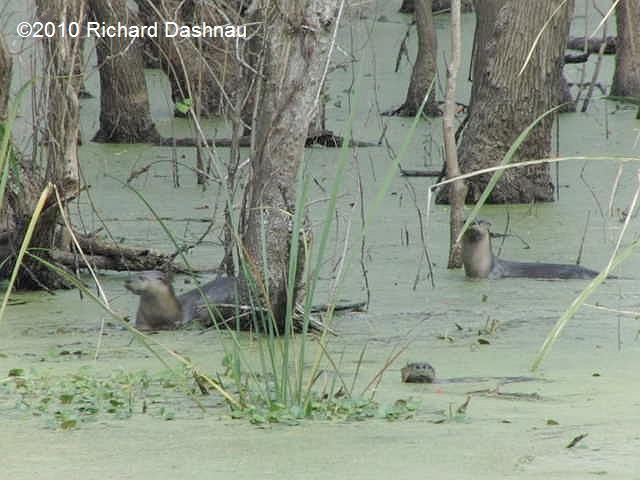 -
-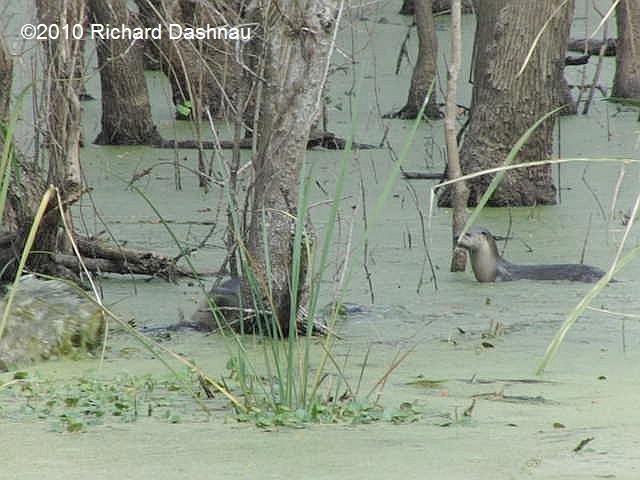 ----
----
I WANT TO PASS, BUT STILL...
UH, OH. I SEE IT NOW
I THINK I'D
BETTER....
....WHOOPS! (LOOK WHAT
HAPPENS)
- --
--
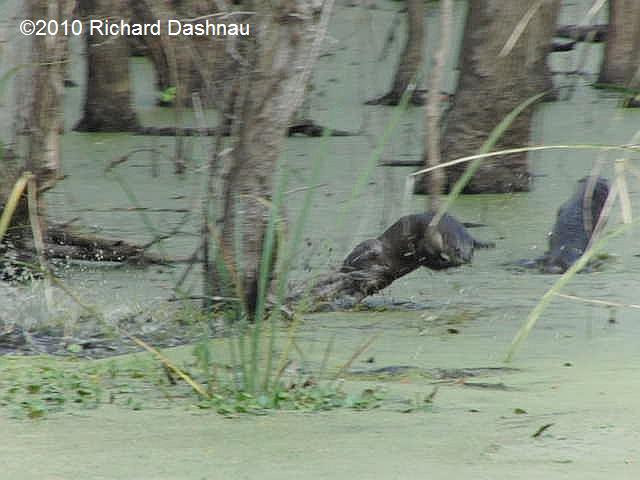 --
--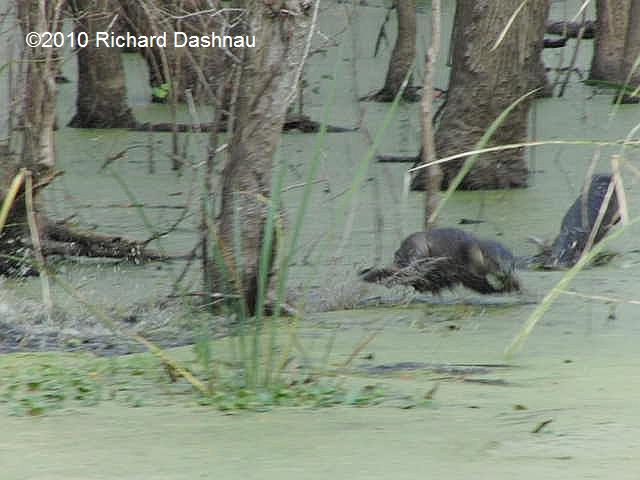 -
-
(IN JUST THESE FEW
FRAMES)
IT'S BEING A GROUCH! DODGE!
LEAPING
AWAY
FOUR-FOOTED
LANDING
 --
-- --
--
RE-SET TO LEAP
AGAIN
SECOND LEAP! OUT OF RANGE.
MEANWHILE,
THE OTHER ONE WATCHES 10/18/2009-
On Oct. 18 (Sunday) I had been out at Creekfield Lake since about 8:00
AM. I was hoping to see an Otter. I didn't have any luck, and I decided
to go back to the VC. I met Sharon entering
the trail as I walking out,
so I decided to turn back and talk to her for a while. As we were crossing
the footbridge, I caught a quick look of something in the water off to
my left (towards the long pier). It was
rounded, grayish, and about 4 inches
thick. As I turned to look at it, it submerged. It was about 15 ft
from the bridge. I looked around, but didn't see whatever it was break
the surface again. But I thought
I saw a couple disturbances in the duckweed
moving towards the bridge. Meanwhile I was thinking (as many of us do),
Was that an Otter? No *way* that could have been an Otter that close.
We stayed
on the bridge for a few minutes, and as we talked, I kept looking
around. I new I'd seen something. Finally, I noticed ripples right next
to the bridge, but when I looked over the rail, I only saw a closing clear
spot in the duck weed. Then, I saw some groups of bubbles moving away from
us, indicating something under the water was disturbing plants, and it
was moving quickly.
An Otter
surfaced about 20 feet away! And it immediately dove, and kept moving away
from us, surfacing briefly. I tried taking a couple pictures, but it submerged
so quickly, I could barely focus. So, I
decided to shoot slow motion video
(since regular would shake too much). I got a few very short clips,
which
only show the Otter briefly. In my haste, I kept moving the camera into
slowmo video mode
instead of high-rate photo mode. It seemed to be moving
towards the center of the lake, so Sharon and I hurried to the long pier
in the hope the Otter would pass us.
It didn't,
but as we stood on the pier,
Tom and his Creekfield Hike appeared near
the bridge. Apparently someone on the hike saw the Otter moving back towards
the bridge. And that was it.
Below
are portions of the only two photos I got
(the back of its head, and a
side view) and some frame grabs from one of the video clips. I've edited
the clips and put them online. Here's a link to the video
clip (mp4)
With
the cool weather, and all the rain, I hope Otters will be popping up all
over!
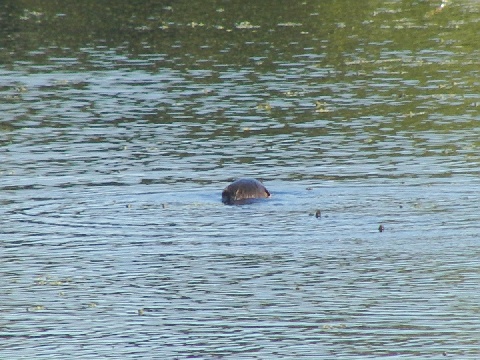 -
- 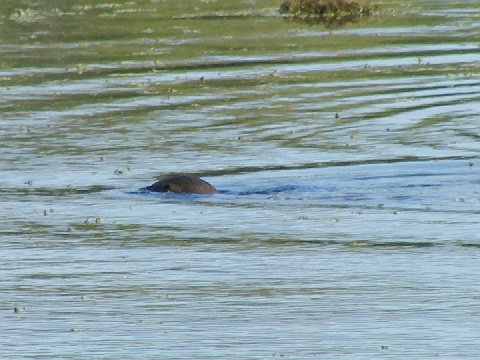 -
-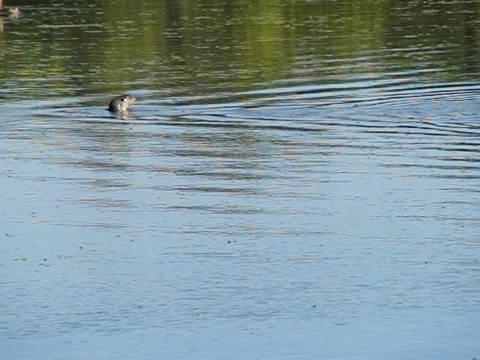 -
-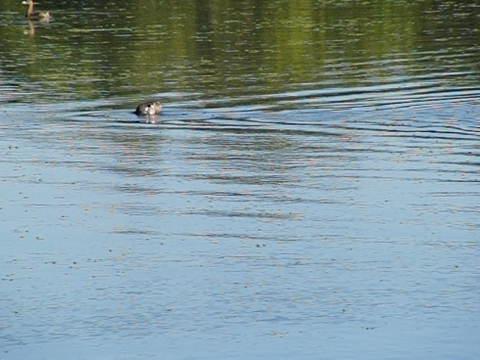
THE
BACK OF ITS HEAD
THE HEAD FROM THE SIDE
RAISING THE HEAD OUT OF THE WATER
-
...AND
BACK STROKING?
02/22/2009--
Today, I was part of the group that had been organized to plant Willow
trees around various lakes around the park. That was fun, and although
I tried, I didn't fill my boots with water. Afterwards,
I left the VC to
go back to 40 Acre Lake to see if I could get lucky and see something interesting,
like a Bald Eagle...or an Otter. And, perhaps because I did something for
the Park today...the Park gave me a
treat.
I don't
remember what time exactly I got there, but I walked to the Observation
Tower from the 40 Acre parking lot, and then just talked to people and
enjoyed the wonderful day. There were two big FAT
nutria lying around the
"island" with the small tree directly north of the Tower. I wandered back
West, and at about 1:50, I caught movement to my left, in 40 Acre lake.
There,
between me and the island, was an Otter. It was just leisurely paddling
along. It stopped, dove, and then reappeared a few seconds later. It repeated
this cycle of movement. It was moving West, so I
walked along with it--moving
when it was submerged. There was a small group of people on the trail (about
6 folks), and I walked toward them. Finally, I called to them when the
Otter was underwater. I pointed,
and told them if they'd watch that area,
they'd see an Otter. And when it popped up, they did see it. As
the Otter swam, it looked towards our bank, then moved on. I knew it wanted
to cross the trail. So, when I
got a few paces past the group of park visitors,
we stopped and waited. It was really cool. We watched the otter just cruise
by.
Meanwhile,
my video camera on tripod was folded on my back, and I didn't want
to look
down and get it. I feared I'd lose the Otter.
I decided
to shoot video with the still camera instead of photos, assuming that it
would cross quickly, and I'd only get still photos of it running. But without
tripod
it would be a bit shaky. So be it.
Of course,
it couldn't be absolutely perfect, and I had a low battery alarm showing.
(Of course! Some of you know how THAT goes.) So, I couldn't shoot continuously.
Meanwhile,
the Otter moved a bit further along, and then swam towards our bank. It
came to shore, paused, stuck its neck WAY up...slid up on the bank, and
then moved up to the trail. Further to the West, and heading our
way, another
park visitor was just walking along quickly, while listening to music through
ear buds.
The
Otter crossed the trail. I filmed it...with my hands shaking with excitement
(yes, I was really happy to see an Otter). Meanwhile, the Otter got to
the other side, paused, and looked back at the approaching fast
walker
(as if to say "Hmph! Imagine that.!"), and then moved into Pilant Lake.
And that was it. Judging by the time stamps on my short short video clips,
this all took about 4 to 6 minutes.
The
park visitors were all
*really* happy to see this. The otter crossed about
20 yards from us. The ipod girl coming from the other direction (her feet
are in some of the pictures below) was also impressed...but she kept walking.
So...no really
clear photos from this encounter. But, some short video
clips. I've edited them together into one clip. You can see
it by clicking on this
link (mp4). Also, the images below are frame captures from the
video clips.
Clicking each one will allow it to be seen a bit larger.
-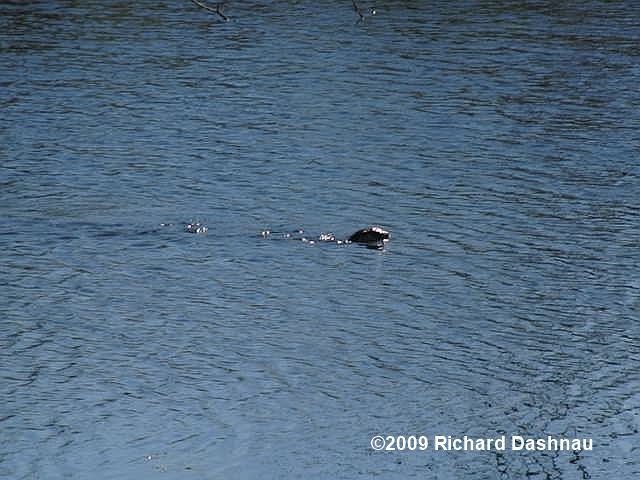 -
-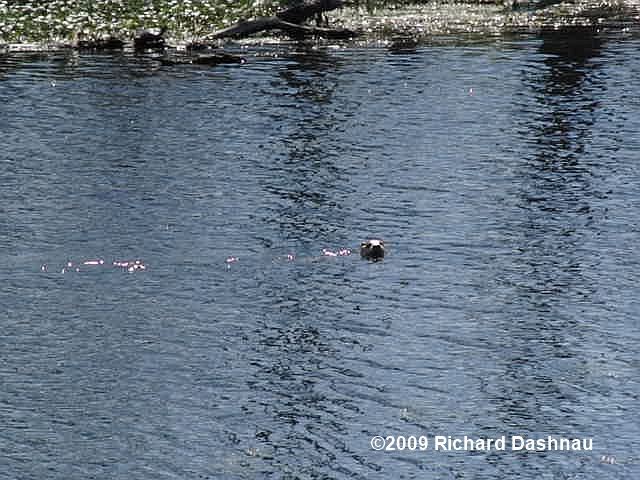 -
-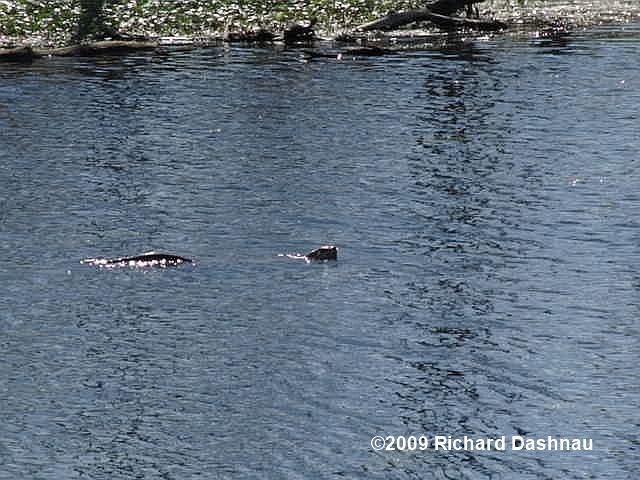 -
-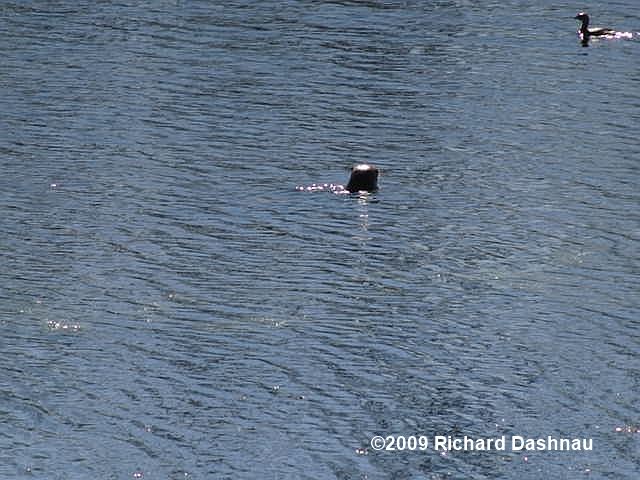
-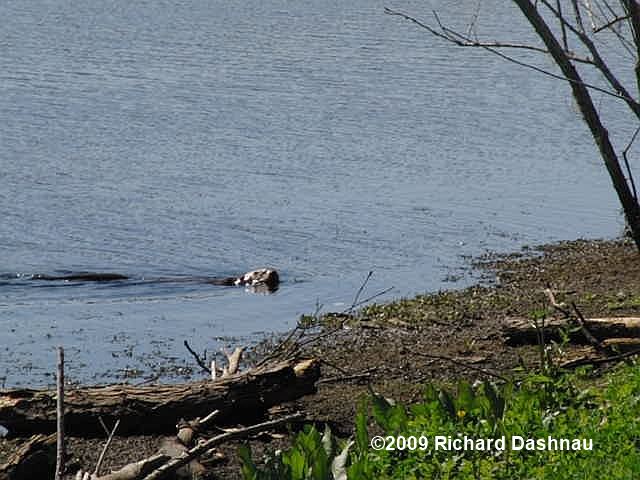 -
-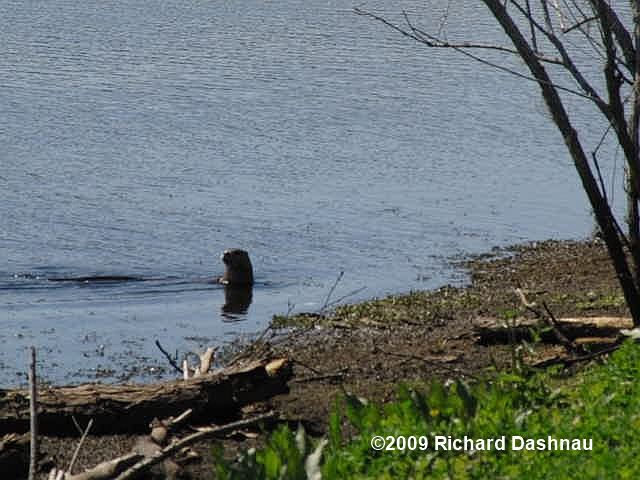 -
-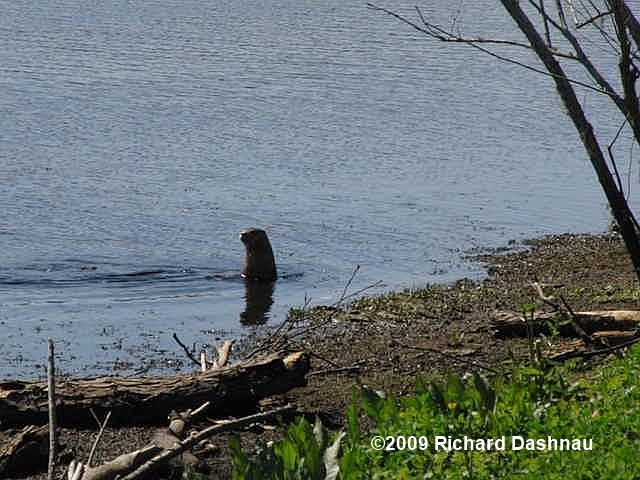 -
-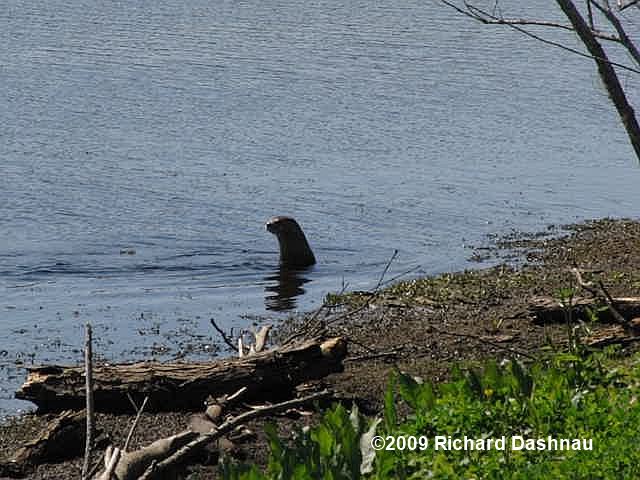
-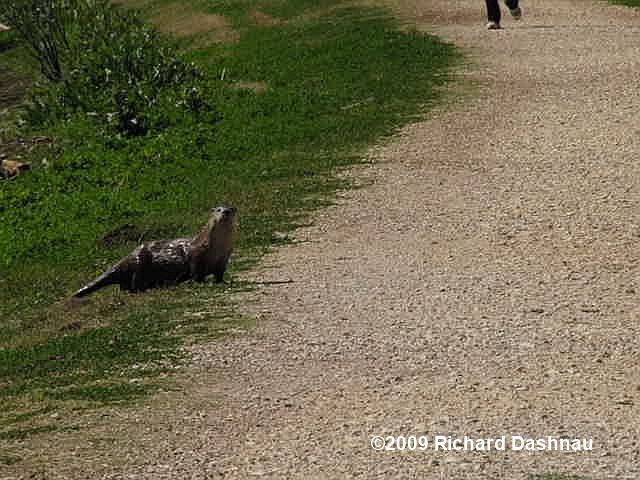 -
-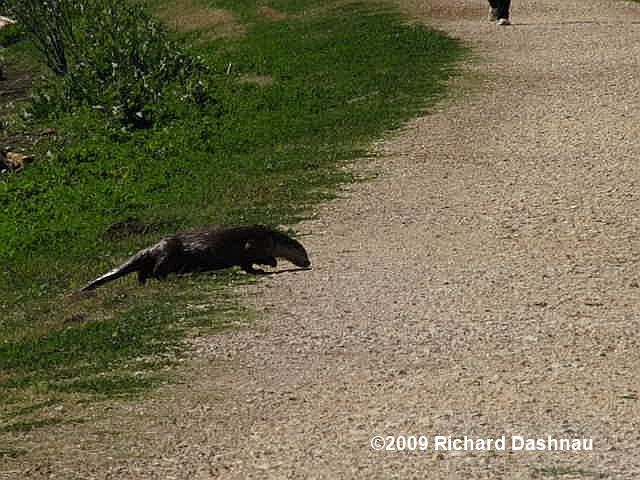 -
-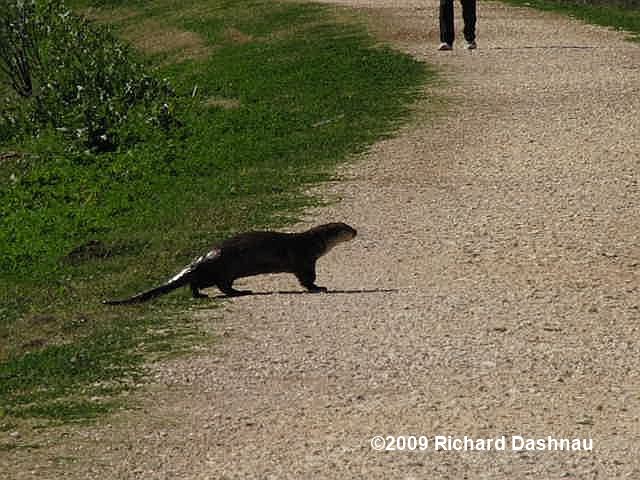 -
-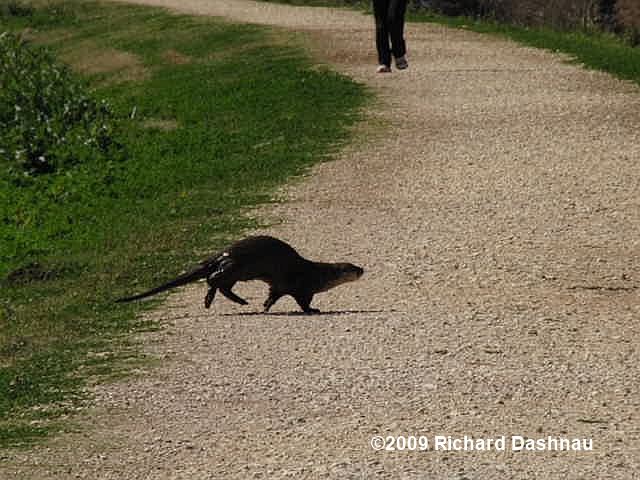
-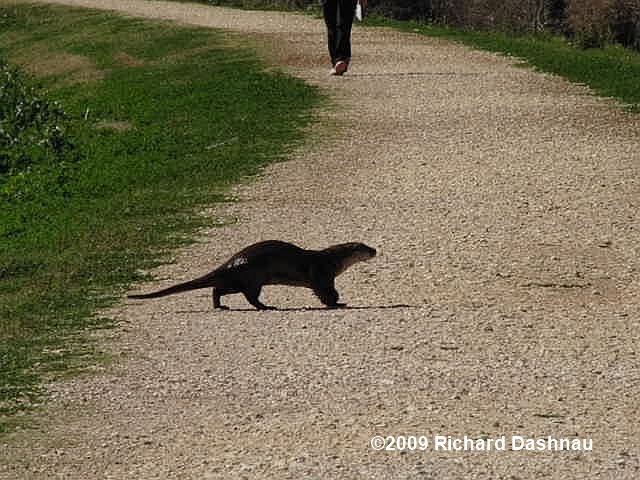 -
-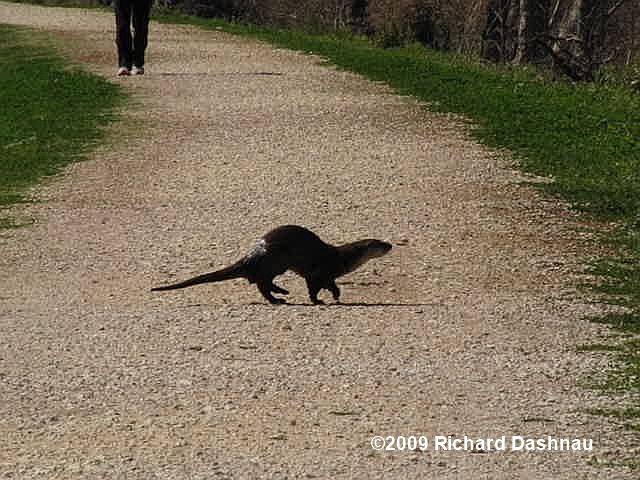 -
-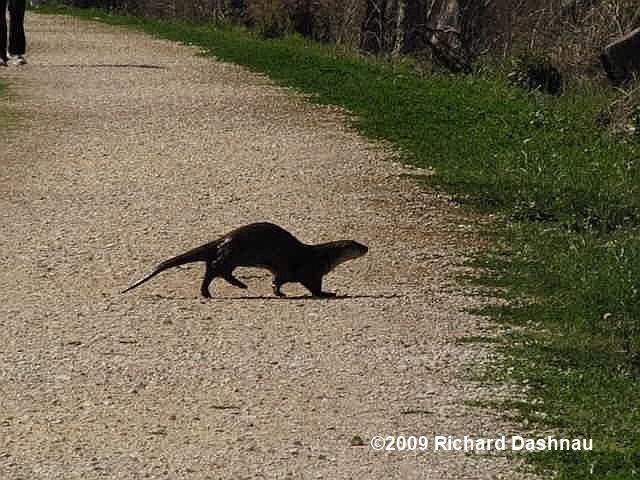 -
-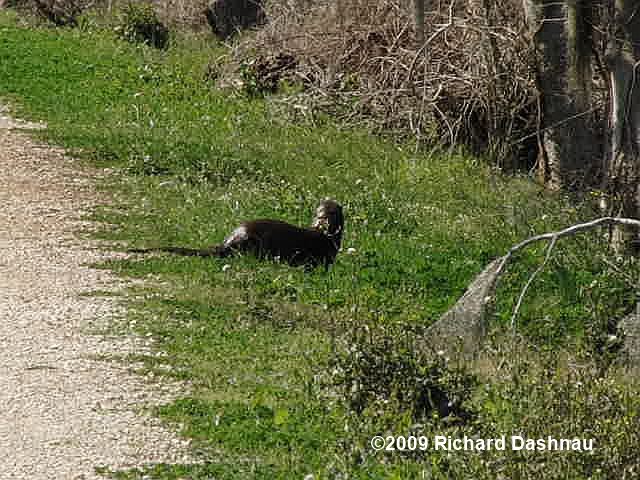
02/08/2009--
I got to the park around 8:00. I headed down towards 40 Acre Lake.
Near the Observation Tower, I ran into a group of people, who told me I
should have been there about 20 minutes earlier.
An Otter had appeared
from the Pilant Slough, crossed 40 Acre Lake trail, and entered the lake.
It got on one of the islands, crossed it, and went to enter the water--where
an alligator threatened it. It backed up,
but eventually did enter the
water where it was chased. It then crossed the North side of the trail
in front of another photographer. AND I MISSED IT! I was really disappointed
by the news--but at least the Otters
are still around! Below is a picture
taken during that confrontation, sent by Chuck Duplant, and used with his
permission. Thanks, Chuck.
----------------
-------------------------ALLIGATOR
FACING THE OTTER
-
3/09/2008--Otter
sighting! I was on the Spillway Trail at about 10:30 when I saw a quick
movement on the trail towards Elm Lake. It was an otter, and I was able
to snap a few pictures, but only after it had crossed
the trail into Pilant
Lake. The image below left shows the otter before it went out of sight.
Not long after, the otter (probably the same one) appeared on Otter Island.
I was able to shoot a short video clip before I lost
sight of it behind
a tree. The other image below is a frame from the video. Click this link
to see the short video clip
(mp4).
- -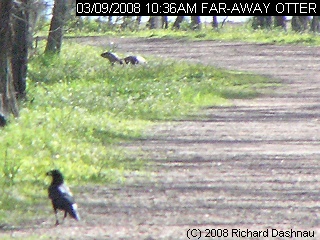
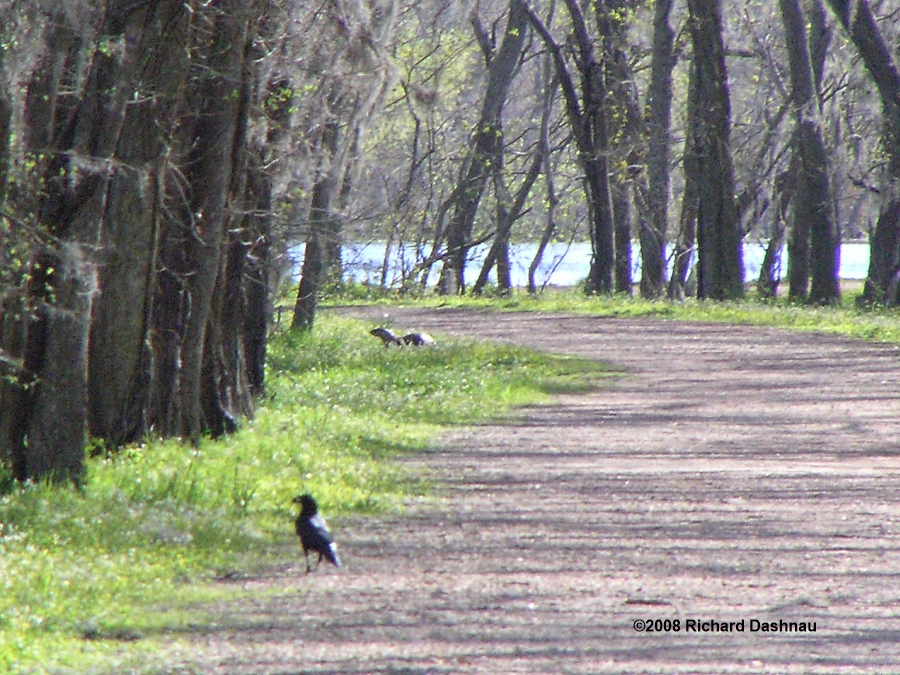
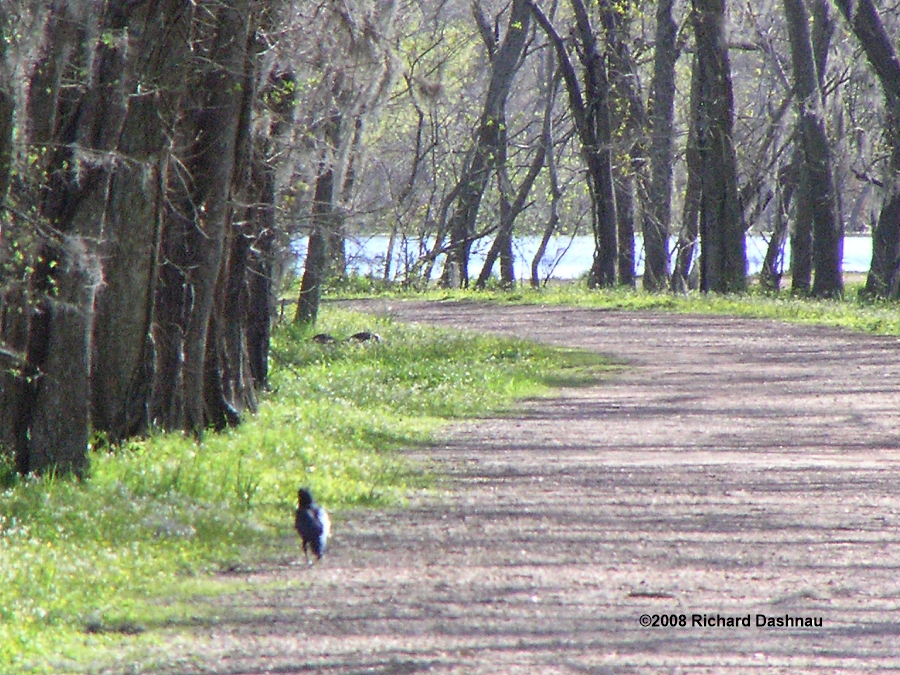

OTTER CROSSING 03/09/08
OTTER PEEKING
03/09/08
2/10/2008--The
weather forecast had promised a nice day, but when I got to the park this
morning, it was still overcast, misty, and damp. I decided to wait around
on the Spillway Trail to look for an otter.
I had been there quite a while
when I encountered one of our frequent visitors, and he told me he'd seen
an otter cross the trail right near where I was standing earlier that day.
It had crossed from Pilant Lake
into Pilant Slough. I had gotten
to the area at around 9:30. The visitor walked off. As I waited,
and watched, an alligator began bellowing somewhere off in the distance.
Others answered, and for about 30
minutes I heard alligators bellow in
irregular choruses. Not long after, I saw a quick movement and turned just
in time to see an otter cross the trail some distance from me, and going
from Pilant Slough into
Pilant Lake between me and the Spillway Bridge.
I only had enough time to watch it bound across the trail. I couldn't even
pick up a camera. But, I was ready, and thought that it might make its
way down the
"islands" and towards me. Unfortunately, one of the Park Rangers
happened to be driving down the trail about 5 minutes later, so I figured
I wouldn't be seeing that otter any time soon.
Finally,
maybe around 11:30, the Sun started to break through. The clouds burned
off, and the temperature immediately increased. Alligators began moving
onto the land. One came up onto one of the small
islands. Another came
up on the trail nearer the Spillway Bridge. Park visitors began passing
by more frequently. I talked for a while with a nice couple that
sounded like they might be from around Australia
or the U.K. We talked
of alligators, and of course I mentioned I was looking for an otter.
A few
hours later, I was discussing alligators with a park visitor, and I noticed
that same "U.K." couple returning from the direction of the Spillway Bridge.
I had just turned my attention to the visitors in front of
me when I heard
a shout from the couple. I looked, and AN OTTER WAS CROSSING THE TRAIL
JUST BEHIND THEM! It crossed again from Pilant Slough to Pilant Lake
(the same direction I'd seen one
cross earlier). I didn't want to
run over and scare it away, so I asked the couple to describe its movements
to me. I finally saw it on one of the small islands, and was able to shoot
a burst of pictures. And then
the otter submerged and was gone. I
waited around the islands, but it didn't show again. The pictures below
were the best I could get. Today's RICKUBISCAM shot is cropped from one
of those photos. Still,
I got to see an otter twice (or two otters?)
at different times today! Between those events, and the alligators bellowing
and moving around, it was a great start to the day!
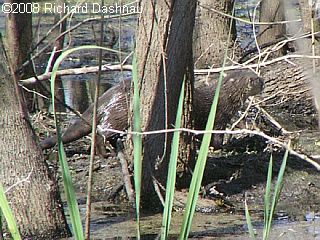
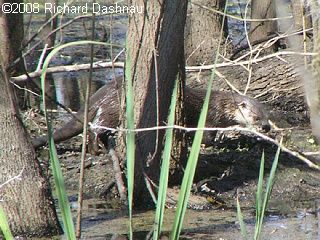 -
-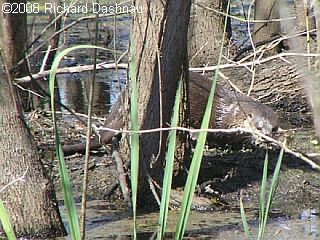 -
-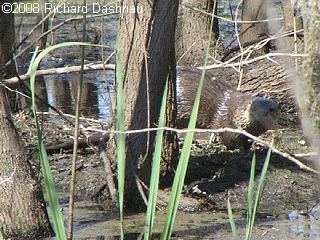 ---
---
OTTER 02/10/08 1
OTTER 02/10/08 2
OTTER 02/10/08 3
OTTER 02/10/08 4
-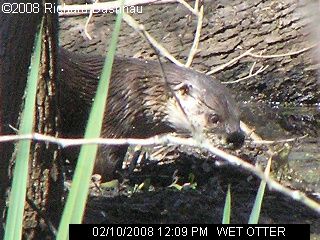
OTTER 02/10/08 CLOSEUP
2/03/2008--Going
into the park, I encountered Chuck on the trail. He told me of his otter
sighting on Saturday, 02/02/08. He had seen an otter very near where I'd
seen it on December 30, 2007 (see below).
So, I set up my camera,
and waited in the area for a couple hours. No otter. I decided to head
down towards the islands along the Spillway Trail (where I'd seen an otter
a few weeks ago--look lower on the
page) and see if I'd get lucky.
Today
was pretty warm, though overcast, and some alligators were up on land basking
in the lack of sunlight (ha!). By the way, this behavior made me wonder
if it's the air
temperature which is the deciding factor in determining
if alligators will emerge from cold water. It obviously wasn't the sun,
since there was none. Even in the coldest weather, alligators must breathe,
and they
don't hibernate. So, when they come up to the surface and inhale,
perhaps there is some sensory input somewhere (in their sinuses, perhaps)
which evaluates the air temperature and makes that decision to
leave the
water to gain heat energy. Just a thought.
I got
near the islands, and had set up to wait. I later decided to move near
the center of the islands, so I could monitor the entire length. Directly
across from me was an alligator looking extremely comfortable
(see FORM-FITTING,
below). I turned on the video camera and focused on the alligator to adjustment
the image. I turned off the camera. Some visitors came by, and we talked
briefly about the alligator, and I
might have mentioned that I was looking
for an otter. The
small group had gone about 20 paces from me when I saw movement in the
water, to the left and behind of the alligator on the island. It was an
otter!
It only appeared briefly and I couldn't get my camera up in time
to catch both animals in frame. I called to the visitors, who came back,
and I pointed to where the otter had been. But it had submerged. The
visitors
walked off, and I figured they thought I was making up stories.
The
three had gone about fifty paces--and were right across from the large
island--when the otter appeared and climbed onto the island!
I called again
(trying not to scare the otter) and told them to turn and look to their
left. They did...and got to watch the otter! How cool is THAT?
Meanwhile,
I grabbed my equipment and moved as quickly and quietly as I could towards
the otter. I stopped some distance off so I wouldn't scare it off from
where the visitors (more had come up after the otter
appeared), and began
shooting from where I was. Between the otter moving behind trees, and me
moving my viewpoint, I got about 4 or 5 really short clips showing the
otter on the island. It was really great to
see the otter again. The other
images below (not the alligator) are from single frames pulled from the
video. The RICKUBISCAM image today is cropped from one of those frame grabs
as well.
-------------------------------------------------------------------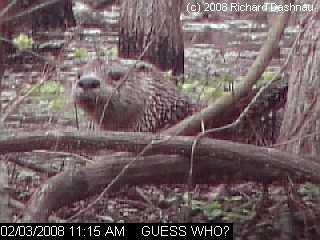
Oh,
yes, and of course there has to be a link to the video clip of the otter
on the island (mp4)
---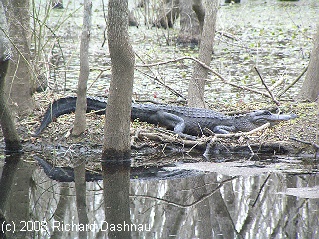 -
-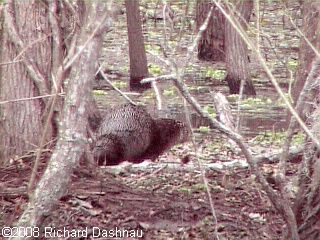 -
-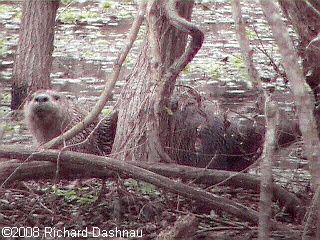 -
-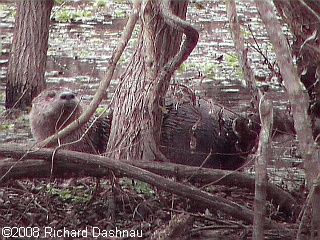
IT'S
LIKE A FORM-FITTING MATTRESS!
OTTER
WALKS
WHO IS THAT?
AND OVER THERE?
-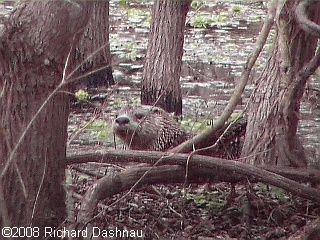 -
-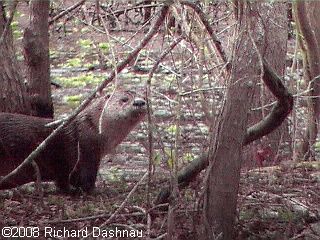
WHERES THE
SUN?
OK. I'M LEAVING!
This
sighting helps illustrate something I've had on my mind since seeing otters
on these islands the first time some years ago (there is some mention of
the sightings further down on this page). It appears
that both the otter(s)
and the alligators find the islands useful. However, it seems that most
of the time each creature is using the island when the other isn't. I can't
be sure, of course, but it seems that the
alligators use it for basking
(and perhaps nesting) in the warmer months; and otters use the islands
as a stopover and basking spot in the colder months. I've wondered what
would happen if conditions were
right for BOTH animals to use the island--hopefully
for basking. I may have almost gotten a chance to see!
1/20/2008--It
was pretty cold this morning when I got to the park. I decided I'd be looking
for an otter again. I walked down to the Spillway Trail, where I set up
my video camera. Then I waited. I hadn't been
there long when I noticed
movement to my right. When I looked through binoculars, I saw a wake, and
a round head. It was a mammal, and it was swimming towards me! I shot a
few still images through the trees.
One of them is below (NUTRIA SWIMS
1). This time, I turned on my camera, and then started recording
I didn't want to repeat what happened a few weeks ago. (see note 12/30/07
below). With mounting
excitement, I framed the approaching swimmer in my
video field and watched it through the camera as it swam past me about
20 feet away. It was a nutria, not an otter. The next image below (NUTRIA
SWIMS 2)
is a frame from the video
clip (mp4). If you watch the clip, notice the nutria's movement
through the water. There is no undulation (up and down body movement) and
it almost seems like it is doing a fast "dog paddle".
--------- ------------------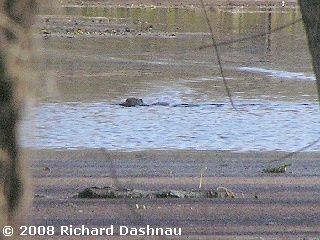 ----------- ------------
----------- ------------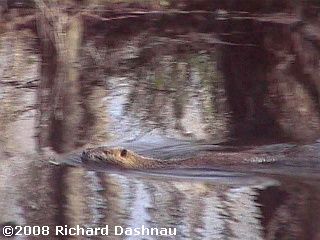
NUTRIA SWIMS
1
NUTRIA SWIMS 2
Although
I was a bit disappointed that it wasn't an otter, I decided to follow the
nutria for a bit; just to be sure. I followed quietly and slightly behind
for about 50 paces. I left my tripod, and just walked with my
still camera
ready. The nutria approached some azolla (this is the reddish-brown plant
that covers patches on the surface of the water. It is not dead duckweed,
but instead a very tiny fern)--and then
submerged. I slowly moved
closer for a few steps, looking for the nutria. I noticed some water disturbance
on one of the islands, and took another step towards the disturbance. There
it was! I spotted the
mammalian head. And, it was moving back towards the
other direction--towards where I'd come from. And...it was an OTTER! The otter was moving a bit faster than the
nutria. It moved towards the islands,
and then moved around behind them.
I walked quietly and quickly, trying to keep pace (and get ahead of) the
otter moving behind the island. I made it to the camera a few paces ahead
of the otter. So, I was
up and ready to focus the video camera when the
otter came into view. And I shot a short, short video (50 seconds) of the
otter moving along one island. I followed it with the camera until I focused
on a tree
directly in front of me. The camera didn't recover focus when
the otter passed until after it had re-entered the water and began swimming
off through the trees in Pilant Lake. I stood still and focused the camera,
and finally snapped off three quick
shots (OTTER SWIMS 1-3 below). Still...I got to see an otter
again! The RICKUBISCAM image, and the last image below (HELLO, THERE!)
are frames from the
video
clip (mp4) Although I didn't get video of the otter swimming
(maybe someday), even the still images show the different profile the otter
has from the nutria. The nutria seems to push through the water,
while
the otter glides through it. Also, at the very beginning of the clip, the
otter is stomping with its back feet while holding the tail up. I believe
that the otter is "sprainting", that is, marking territory.
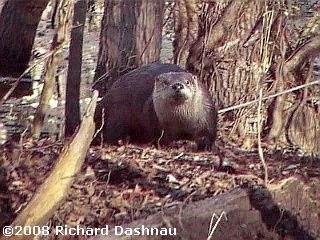 -
-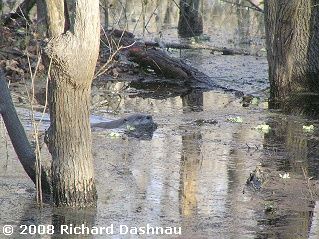 -
-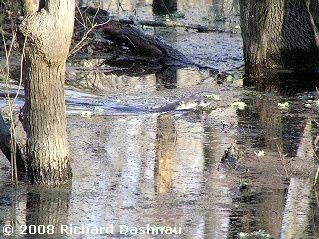 -
-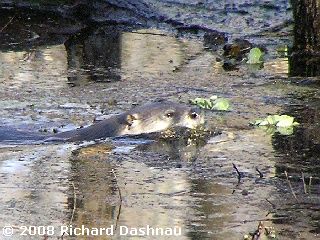
HELLO, THERE!
OTTER
SWIMS 1
OTTER SWIMS 2
OTTER SWIMS 2-CLOSER
-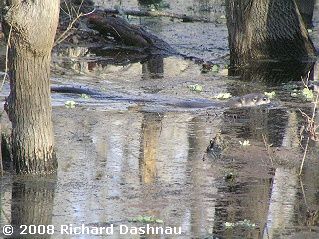 -
-
OTTER SWIMS 3
I gathered
my gear, and started walking. I thought I might try to catch the otter
near another lake. But, I stopped to film a Piliated Woodpecker drilling
a tree. I had just picked up my gear again, and was
turning towards Elm
Lake, when a Bald Eagle flew right over me, fairly close. I had my hands
full of equipment, so I couldn't grab any of my cameras. Not bad for a
freezing morning!
12/30/2007---Otter
sighting! After I got to the park on Dec. 30, I saw Chuck on the 40 Acre
Lake trail. He told me that Glen had had an otter sighting
Saturday
(Dec 29), at around 1:30pm, near where we
were standing on the 40 Acre
Lake Trail.
This
was somewhere in front of the second island, counting from Hoot's Hollow.
I was walking back towards my car at around 12:30, when I decided I'd wait
around where the otter had been seen until about 1:30. As I was in
the area, talking to visitors walking by and so on, I decided that it might
be good to try for
a video
of the otter, instead of just pictures.
Not really expecting to see
the otter, I leisurely extended and opened my tripod. I got my video camera
out of my backpack. I changed the battery on the camera, and set it up.
Not long after this, I saw
movement near the island, and I saw a head moving
across the water away from the island, and towards the trail. It was an
otter!
Heart
thumping in my chest, I turned on the camera, and was able to get it focused
on the otter. As I watched, the otter submerged, surfaced, submerged,
surfaced; and then paused as a visitor walked by.
The otter was moving
towards a tree at the water's edge. When the visitor walked by, the otter
swam to the
bank,
climbed out, and paused on the root of that tree. Then, it pawed around
in the grass for a
few seconds more.
Meanwhile,
I was watching all of this through the viewfinder of my camera. I had zoomed
in enough so the otter filled the entire field. The light was perfect!
The
otter was in focus!
Finally
the otter moved across the trail and into Pilant Lake. I panned across
with it, following the otter easily with the camera. The entire episode
took about 30
seconds.
When the otter moved from sight,
I was exultant! What a shot! Then I moved
to press the stop recording button...
...And
THAT is when it STARTED recording! ARGH! AAAARGH! I did record the
words I said when I saw that I'd missed the shot, though. We won't be hearing
that.
I came
back Monday (12/31/07) AND
Tuesday (01/01/08) and stayed in that spot from
about 10am to 2pm each day but the otter didn't reappear.
02/18/2007 (updated w/ new pics and remastered video 1/27/2022)---Sunday
was a beautiful day. I made my way to New Horseshoe Lake where I found
an medium alligator (about 9' long) on the back
side (past the bench) with
some kind of mammal in its jaws. The fur was kind of coarse, with a reddish
highlight, and the animal seemed sort of long (like--otter-shaped). I spent
a little over four hours
watching and waiting for the alligator to move
the carcass enough to let me see what it was.
Considering
how cold it's been during the evenings, it's surprising that an alligator
is eating *anything*,
especially something this large. I don't think there's
any way to tell what happened, or even how old the carcass is. The alligator
could have found it. The alligator could have killed it. With weather
conditions
as they've been, it's conceivable that the carcass could be many days old,
with the equivalent of it being placed in a refrigerator every evening
when temperatures dropped below 40
degrees F.
During
all that time, I got a chance to interpret for many park visitors. Sometime
in the mid afternoon, as I was describing what I thought the furred creature
probably was (a nutria) and what I
hoped it wasn't (an otter), a couple
of park visitors nearly knocked me out with this set of statements:
"An otter?
We just saw one."
"WHAT!?
Where?", I said. And they told me. It was down on the Spillway trail,
on the island which I like to call "Otter Island".
Of course,
I gave my usual congratulations and explained that that's a rare event.
I also thought, 'Oh, well, there goes another missed chance.'
Later,
some other visitors also reported seeing the otter, and a some stated
that it was just lying around on the island. I just had to go see it!
But
I couldn't leave. I hadn't found out what the alligator was holding, yet.
Finally,
the alligator moved forward one more time. In over 4 hours, it moved its
feet a few times, lifted its head and grunted thrice in a row, slid forward
about
one foot, then shifted forward again about a foot. That's it. Well, unless
you count opening and closing its eyes. It did that lots of times.
I call
this
"living in 'Alligator Time'". Through my binoculars, I finally saw
a broad, flat, "scaly" tail. The dead mammal was a beaver, and the alligator
had it by the head.
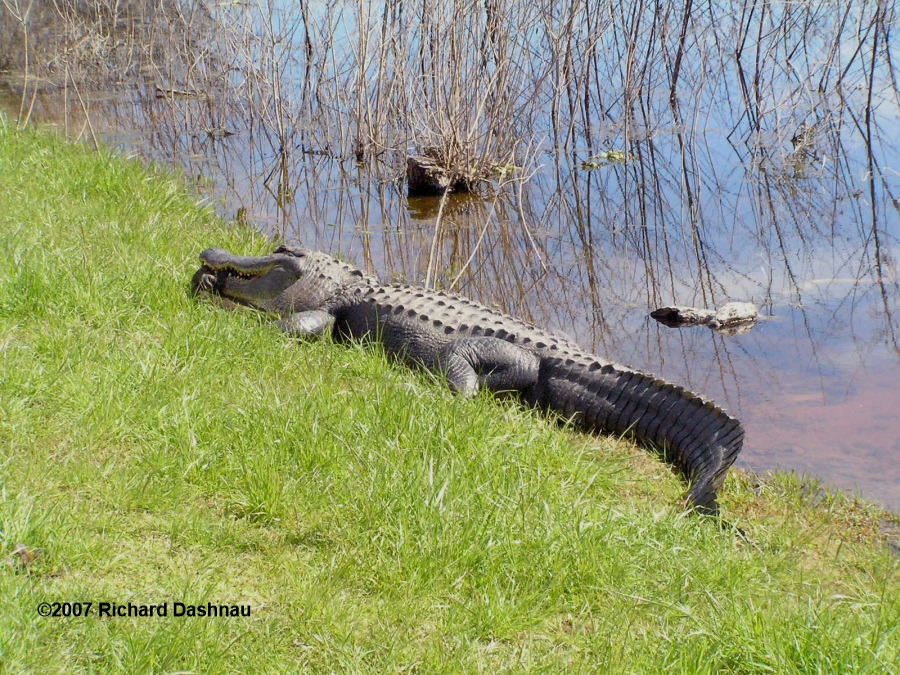


-------------------------------------------------------------------
--------------------------- ------BEAVER'S
END
To my
great joy, the otter was still there! I watched it for about 30 minutes.
For most of the time, it appeared to be sleeping, although every now and
then
it would lift its head, and turn around (like a dog does), then lie down
again. Some visitors passing by were unimpressed when I pointed it out
to
them---since
they passed by the otter already, and had seen it moving around.
How about that? Can you imagine being bored by seeing an otter?
Finally,
it moved around, groomed itself, and did other things, before it swam off.
Because it was dozing most of the time, of course I had to turn off my
video
camera
from time to time, and hustled to turn it on when there was movement. As
a result, I have a lot of footage of a quietly breathing lump of fur. But,
I
have
a few minutes of ok video. Was I lucky again? Oh, yes. VERY
lucky, especially considering my otter encounter just two Sundays ago!
(Look lower on
this
page for details.)
Below
are some images taken from the video clips. Let's watch an otter enjoying the day! Here's the edited video (mp4).
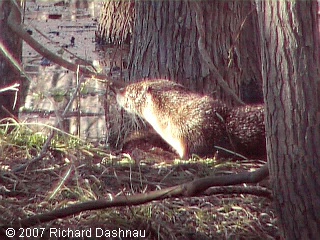 -
-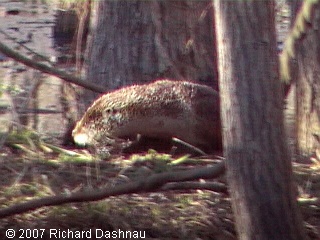 -
-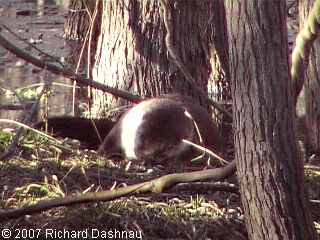 -
-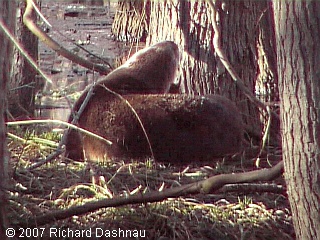 -
-
--- ----SLEEPY
EYES ----
------- ---------TURN
AROUND---------
--------OOH,
MY BACK....---- -----------GET
THE EARS, TOO-
-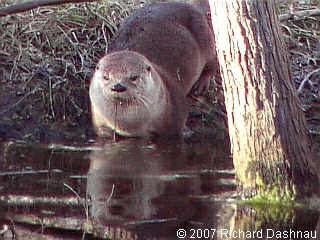 -
-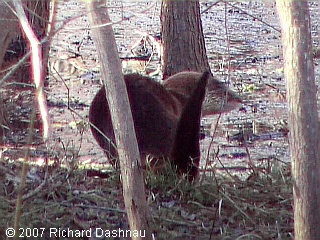
A
VEGGIE SNACK-
GIVING
THE STRAIGHT POOP
The
River Otter (Lutra Canadensis=Lontra Canadensis) is a mammal, in the same
family as weasels, ferrets and skunks. This family is Mustelidae. The full
breakdown goes like this:
Kingdom:
Animalia
Phylum:
Chordata
Class:
Mammalia
Order:
Carnivora
Family:
Mustelidae
Subfamily:
Lutrinae
Genus:
Lontra
Species:
L. canadensis
Adults
can be up to 51 inches long (over 4 feet), and weigh up to 30 lbs.
Adult females and young up to one year old can form social groups, but
males are usually solitary. The otter can swim 6-7
mph at the surface and
it can travel 1/4 mile underwater before coming up for air. It can hold
its breath for about 4 minutes. The
otter must keep its fur cleaned to keep its insulating properties. To
do
this, it will roll around, and also groom itself. When marking territory,
the otter will sometimes "spraint", that is, use its feces as marking media.
Think about this the next time you see graffiti
defacing something--and
be glad that otters weren't doing the marking. Fellow Volunteer Chuck
and I watched the otter "dancing" (see the last clip), and he thought it
was scent marking, and I thought
it was pooping. Turns out we were probably
both right. I've had a few other otter sightings at BBSP, and you can read
about them on this page.
My
sources for this information are various sites on the worldwide web.
I've tried to cross-reference and use what I thought were the best sources.
Here are a few links to otter-related sites:
Animal
Diversity Web Otter
Specialist Group J. Scott Shannon's
Otter Album
02/04/2007---An
otter sighting. February 4, 2007. I got to BBSP about 8:30
am. It was a bit chilly outside, and I grabbed my usual equipment
and walked down to the 40 Acre Lake trail, passing Hoot's
Hollow. As usual--during
weather like this--I entered the trail hoping for at least one of two things:
First--to
see a River Otter. Second--to see a Bald Eagle.
I exchanged
greetings with a park visitor who was trying out a new camera, and rounded
the first bend. I could see the Bird Hike group in the distance. I
walked
up the trail, looking around as usual. I got to within about 50 yards of
the Bird Hike Group. When I looked towards them, movement on the water
caught my
eye.
To my right (this would be South), near the islands at Elm Lake, I saw
a large wake moving towards me. This was some distance away. My first thought
was
'alligator!',
because that's usually what makes a wake of such prominence and speed.
But, I remembered how cold it was and that--although I could make out a
gray head--it was rather cold for an alligator
...and that head was high
in the water. Then I thought 'nutria' and at the same time as I thought
*this*, it dove. The
dive
was a smooth roll forward, like watching a porpoise or...
...
'an OTTER!'
Right
about the time I had the thought, I heard Mark Garbutt call out "OTTER!".
I pulled up my camera, and began shooting. I had the camera set to take
5-shot bursts. The first series of photos here shows
the otter performing
another dive. See the tail up?
-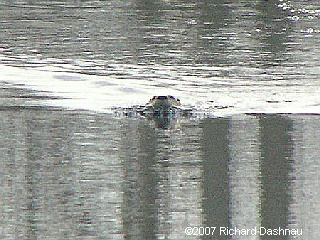 -
-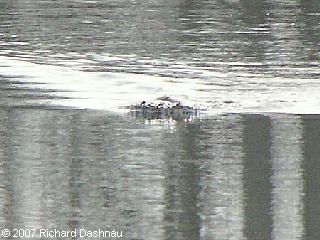 -
-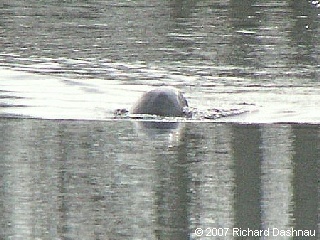 -
-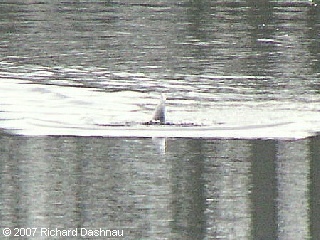 -
-
-------- ---UNKNOWN
CREATURE? -----
------------DUCK
THAT HEAD----------
--------- -SMOOTH
DIVE--------- -- --- AND
THERE'S THE TAIL--------------
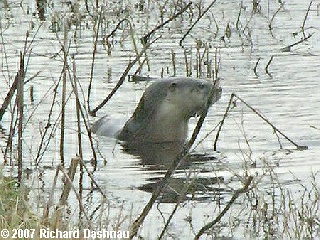
OTTER
AT THE BANK
After
the dive, it stayed submerged. ' Where is it? ', I wondered. 'It's
going towards the island.', I thought, 'Too many people on the trail'.
But
then I saw the trail of tiny bubbles.
And
they were headed...right...towards...ME!
I stood
as still as I could, with my heart flipping. The otter surfaced about
30 feet away. It came to the bank, and then a commotion near the
island
made it turn and look that way. I shot 5 pictures, but it didn't
move much. Here is one of them (see OTTER AT THE BANK, above).
While
the camera saved these images, the otter came ashore. 'HURRY camera.
HURRY! ', I thought. The camera was ready. I shot again, without much time
for focus. Here are 5 more shots of the otter on the trail.
-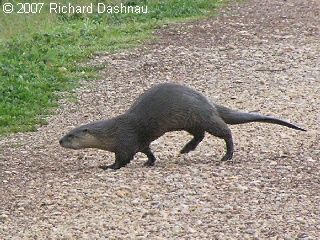 -
-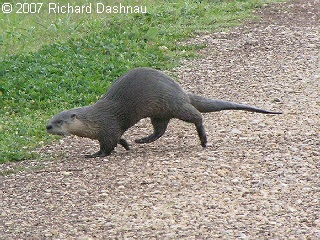 -
-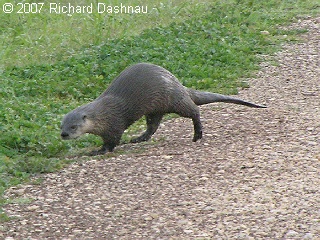 -
-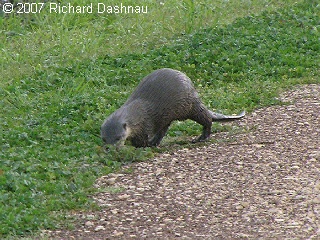 -
-
-- ----------STEPPING
ACROSS ---
--------------- THE
TRAIL-------
----------- BUT
WAIT. WHAT IS...--------- - --- ....THIS
HERE?-------------
---
My heart
was in my throat as the otter is almost close enough to touch--with a really
long stick, maybe, but still---an otter is RIGHT THERE!
You
can see in this series that the otter takes time to smell the roses, so
to speak. Chuck Duplant got a picture of me and the otter during this time,
which he
was
kind enough to send to me. Thanks, Chuck. (see THAT'S ME, below)
-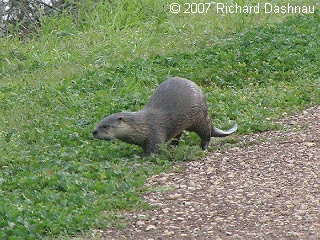 -
-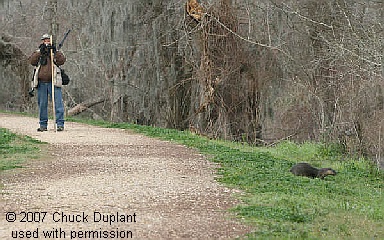 -
-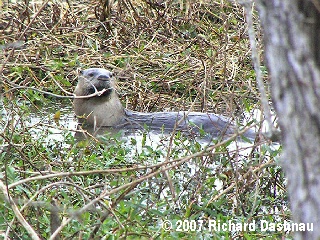 -
-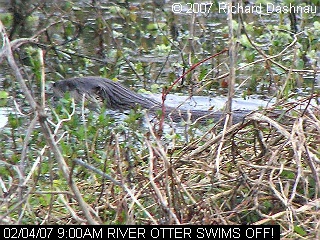 -
-
----NOTHING HERE, I GUESS.----
THAT'S
ME WITH THE OTTER! ----
----I'M
READY FOR MY CLOSEUP --- --------GOODBYE,
OTTER
Then
the otter slid into Pilant Lake. I still stayed, rooted to the spot.
The otter stopped, laid out, and looked at me for a bit. 5 more pictures
with little movement. Here is one of them (see I'M READY FOR MY
CLOSEUP,
above). Finally, the otter leisurely slid over some more plant mat,
and under the water into Pilant Lake. The last shot above (GOODBYE) is
a shot of the otter leaving. And that was my close
encounter with
one of our favorite park visitors. It will take a lot to top this.
I hope
y'all enjoy the pictures. Judging by the time stamps on my photos,
the first picture was taken at 8:59, while the last was taken
at 9:00.
Everything
that
I described happened within ONE MINUTE!
Something
that I said some time ago applies here. I've said that BBSP will occasionally
give someone a "gift". Sometimes the recipient is a first-time visitor.
Sometimes it's a volunteer who's been out on the
trails every week.
Regardless, anybody--at any time--could be the recipient of one of these
"gifts". The gifts I'm talking about are those one-in-a-million--and maybe
once in a lifetime--experiences with nature.
The more time you spend
out on the trails, the better your chances of seeing something really,
really wonderful. But someone's first visit to the park could also
yield something, too. Can you imagine what
someone from another,
less tropical, country must feel if they happen to see a live, wild alligator
walk across a trail 15 feet in front of them? I've been fortunate
enough not just to see the alligator cross in such
a situation; but to
see wonder in the faces of our foreign visitors when this happens. I'm
twice-gifted on those occasions.
This
morning, I was lucky many times over. Lucky that I didn't go by 5
minutes later, or 5 minutes earlier. Lucky the otter came my way. Lucky
that the camera stayed in relatively good focus. Lucky that sky was
overcast
(the otter was swimming towards me out of the sun). Probably also lucky
that I had the camera set for burst mode because I had been trying to capture
gnat catching birds hovering. My reactions to
what I saw, along with
my experience, allowed me to take advantage of my luck, but that's minor
compared to the number of conditions that just happened to fall my way.
This
is not my first, or only encounter with
a River Otter at Brazos Bend State
park, but it is certainly one of my best encounters. For descriptions
of two other otter sightings, and more information about River Otters,
you can scroll up to the entries for
February and March of 2004.
March
07, 2004 (revisited)
The image below left (OTTER!) shows one of our most popular--though rarely
seen--park visitors, a River Otter (Lutra Canadensis). In my previous
note on March 7 (see below), I
mentioned that we had seen a river otter
on one of the Pilant Lake islands; in fact I'd seen one there about a week
before. I also mentioned that one of the other volunteers, Dylan
Lawrence, had gotten some video
footage of the otter. Now...that footage
is only about 15 seconds long, but it has caused quite a stir among those
of us who enjoy Brazos Bend State Park. The otter is clear, and fills
the screen with wet, furry
goodness!(Yes, I meant to write that.)
Well,
Dylan has managed to digitize this clip (in 160 x 120 mjpeg format), and
he's allowed me to use a copy of it (yay! Thanks, Dylan!). Working from
that, I was able to
expand it to 320 x 240 resolution, and still keep it
clear enough to see. Along the way I was able to brighten it a bit. You
can see a flv video version of the expanded clip here
(flv video, 572 kb), also. The four other
images below are also from
the expanded clip (all of this probably would have been clearer if the
file was originally made as a 320 x 240, but there you go.). I'd considered
posting a flv video version of the original
file, but the file size is
about the same, and the video is half the screen area. So I didn't.
Expanding the video has caused it to "fuzz" slightly, but it's still clear
enough to see.
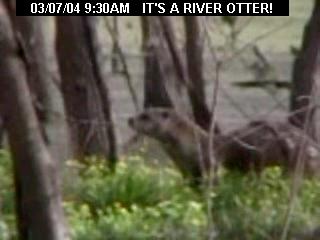 -
-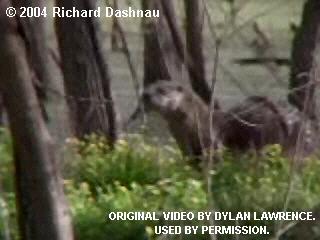 -
-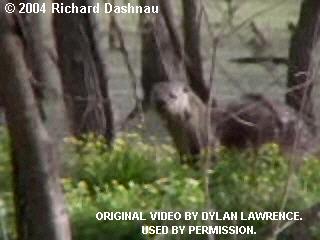
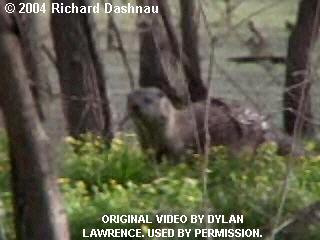 -
-
OTTER!
AMPHIBIOUS CARNIVORE
IS THAT A VIDEO
CAMERA?
HERE'S LOOKING AT
*YOU*

MOVING OUT
The
otters that occur at the park have generated a few interesting stories.
For one thing, many park visitors, when told that River Otters show up
at the park, are surprised and/or skeptical.
A couple
that has been coming out to BBSP for a number of years looked at me very
oddly when I mentioned the otters. Basically, they said that not only had
they never seen one, but they had never *heard*
that otters lived at the
park in all those years that they've been visiting. I thought I could detect
a healthy amount of skepticism. I didn't blame them. The otters have attained
somewhat mythical status even
among those that *know* they live here. I
think it was about 3 weeks after our conversation when the otter in this
video clip showed up. Guess who the two people on bicycles were that
spotted the otter and
called us over? I guess they aren't skeptical
any more.
One
visitor told our naturalists of some beavers that he'd photographed at
the park, only when the photos were viewed, we saw that they were otters!
David
Hienicke, one of the park naturalists had a
wonderful 20-minute interaction
with an otter.
On a
sadder note, one of the otters was killed by a car on our "Mile
Stretch" last year; and I'd like to give this reminder: Folks, follow
the signs
and instructions at the
park. The speed limit signs are there not only
for the protection of our human visitors, but for our animal inhabitants
as well. The park is their *home*. Please respect it, so that they'll
be around for everyone to
see and enjoy.
Otters
are interesting to me (yeah...I know, just add it to the list of animals
I think are interesting), for a number of reasons. At Brazos Bend State
Park, it's interesting to *me* that they seem to share an
ecological niche
with the alligators. Otters move around on land and in water without too
much problem, although they have evolved over time so that they work more
efficiently in water (like alligators have).
They hunt all kinds of aquatic
animals (like alligators do). Some of the time, they wouldn't hesitate
to make a meal of a alligator that is small enough (and an alligator wouldn't
hesitate to make a meal of an otter
that is SLOW enough!).
It's
also interesting to compare the range and population of these two similar
predators. A large number of alligators can be found in a habitat like
Brazos Bend State Park, and they
can live there comfortably, with the alligators
themselves regulating population density (that is, if there's enough food).
On the other hand, the number of otters that would be found in an area
the same size
would be *much* less. According to some sources, the range
of a single otter can cover miles. This could be an illustration of the
comparison
of prey density to predator density. Cold-blooded predators generally
consume
less food then their warm-blooded counterparts, so a certain amount of
food in an area will support more cold-blooded predators than warm-blooded
ones.
Or,
it could just be that female alligators make more offspring than female
otters do (20-60 young for alligators; 1-5 for otters). Or, that mature
alligators (6 feet long or over) can eat otters of *all* sizes (since they
hunt in the same environment, and so could cross paths), while adult otters
can only eat immature alligators *below* a certain size. Perhaps, as seems
to be the case with ecology, it is a complex balance of all
these factors,
plus some we don't know about.
I'll
take a slight detour here to mention something about whales. Whales
are generally thought to have evolved over time from related mammals that
were terrestrial; that is, they lived on land. There was an ancient
mammal,
ambulocetus
natans, which is thought to be a sort of "crossover" animal form between
the land-living mammals and those that became fully aquatic. Certain elements
of its skeletal anatomy show a
relationship to ancient whale species. That
ancient mammal was about 12 feet long, and it is thought to have spent
most of it life in the water, ambushing prey at the shoreline--much like
a crocodilian would.
Otters,
to me, seem to be a similar type of creature. That is, a mammal that hasn't
lost its ties to land living, but is only a few steps away from doing so.
To learn
a bit more about River Otters in Texas, go to the
Online
Edition of the Mammals of Texas.
February
29, 2004
Today's weather was overcast and rainy, but some alligators came out anyway.
After checking on some of them, I was moving down the Spillway Trail. I
moved down the trail, and started looking
on one of the Pilant Lake islands
for another really big male alligator that basks there sometimes. I didn't
see him, but I saw the quick, furtive movement of a small dark mammal.
I thought it probably was a nutria, but
I hoped it was something else.
It looked like it from the corner of my eye, but I couldn't be sure. I
got my camera ready, and decided to shoot a video clip, because if I saw
it again, it would be moving quickly. There! A
dark, wet form was undulating
over the ground! It was AN OTTER! I think I saw it for about 6 seconds,
and caught this glimpse with the camera. See the clip HERE
(flv video 222kb) or HERE
(mpg 1363kb). Yes, otters
do appear at the park, and for almost 2 years
I've been looking unsuccessfully for one. I've finally gotten to
see one! And now, you can see one, too! (although very briefly).
If you'd like to know more about the park follow these links:
Brazos
Bend State Park The main page.
Brazos
Bend State Park Volunteer's Page The
volunteer's main page.
Go back to my home page, Welcome
to rickubis.com
Go
back to the RICKUBISCAM page.
Go
back to the See the World
page.







































































 --
-- --
--




































































